2025-12-07 23:00:00
I’ve been working on internal “AI” adoption, which is really LLM-tooling and agent adoption, for the past 18 months or so. This is a problem that I think is, at minimum, a side-quest for every engineering leader in the current era. Given the sheer number of folks working on this problem within their own company, I wanted to write up my “working notes” of what I’ve learned.
This isn’t a recommendation about what you should do, merely a recap of how I’ve approached the problem thus far,
and what I’ve learned through ongoing iteration. I hope the thinking here will be useful to you, or at least validates
some of what you’re experiencing in your rollout. The further you read, the more specific this will get,
ending with cheap-turpentine-esque topics like getting agents to reliably translate human-readable text representations of Slack entities into mrkdwn formatting of the correct underlying entity.
I am hiring: If you’re interested in working together with me on internal agent and AI adoption at Imprint, we are hiring our founding Senior Software Engineer, AI. The ideal candidate is a product engineer who’s spent some time experimenting with agents, and wants to spend the next year or two digging into this space.
As technologists, I think one of the basics we owe our teams is spending time working directly with new tools to develop an intuition for how they do, and don’t work. AI adoption is no different.
Towards that end, I started with a bit of reading, especially Chip Huyen’s AI Engineering, and then dove in a handful of bounded projects: building my rudimentary own agent platform using Claude code for implementation, creating a trivial MCP for searching my blog posts, and an agent to comment on Notion documents.
Each of these projects was two to ten hours, and extremely clarifying. Tool use is, in particular, something that seemed like magic until I implemented a simple tool-using agent, at which point it become something extremely non-magical that I could reason about and understand.
Imprint’s general approach to refining AI adoption is strategy testing: identify a few goals, pick an initial approach, and then iterate rapidly in the details until the approach genuinely works. In an era of crushing optics, senior leaders immersing themselves in the details is one of our few defenses.
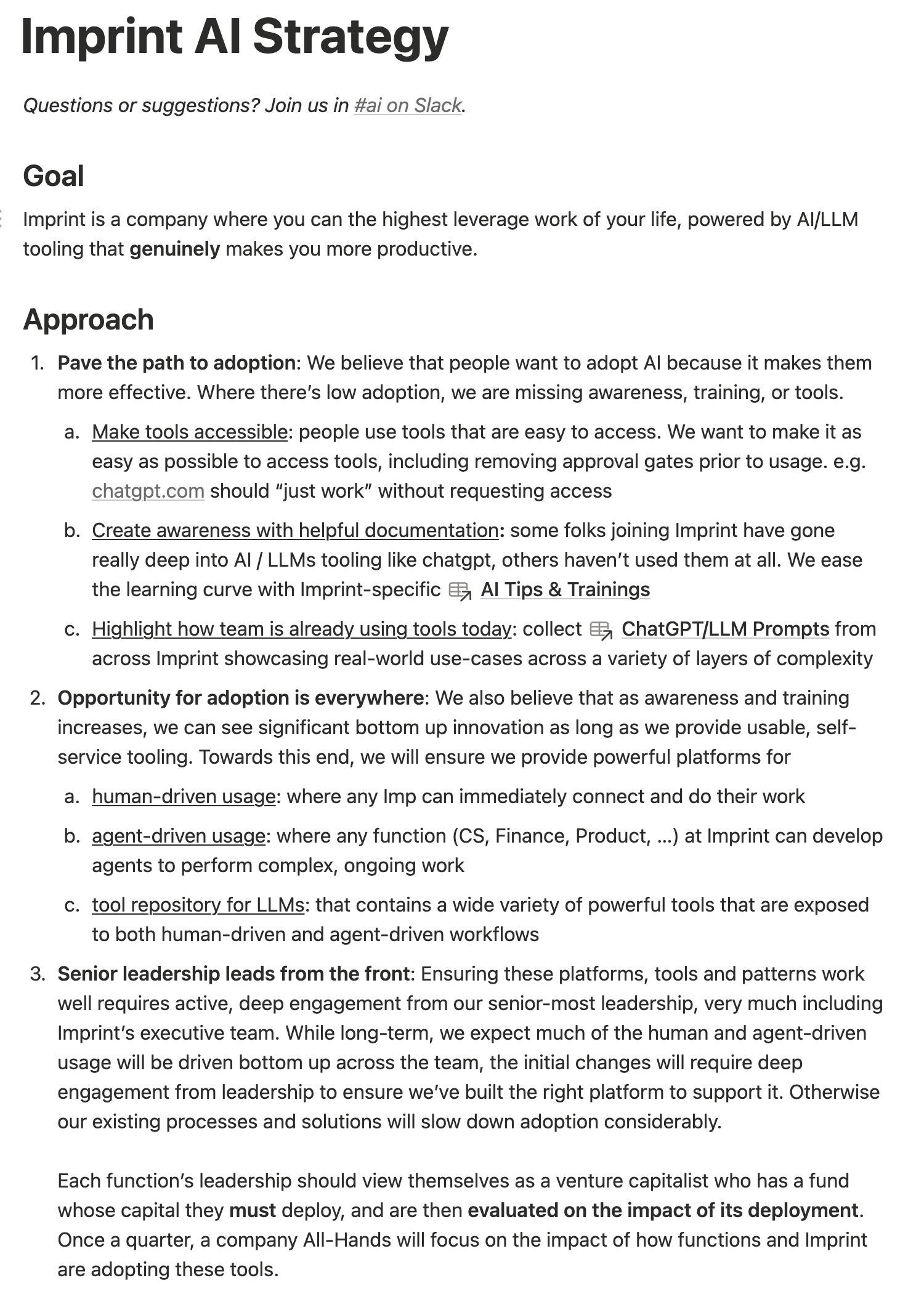
Shortly after joining, I partnered with the executive team to draft the above strategy for AI adoption. After a modest amount of debate, the pillars we landed on were:
As you see from those principles, and my earlier comment, my biggest fear for AI adoption is that they can focus on creating the impression of adopting AI, rather than focusing on creating additional productivity. Optics are a core part of any work, but almost all interesting work occurs where optics and reality intersect, which these pillars aimed to support.
As an aside, in terms of the components of strategy in Crafting Engineering Strategy, this is really just the strategy’s policy. In addition, we used strategy testing to refine our approach, defined a concrete set of initial actions to operationalize it (they’re a bit too specific to share externally), and did some brief exploration to make sure I wasn’t overfitting on my prior work at Carta.
My first step towards adoption was collecting as many internal examples of tips and tricks as possible into a single Notion database. I took a very broad view on what qualified, with the belief that showing many different examples of using tools–especially across different functions–is both useful and inspiring.
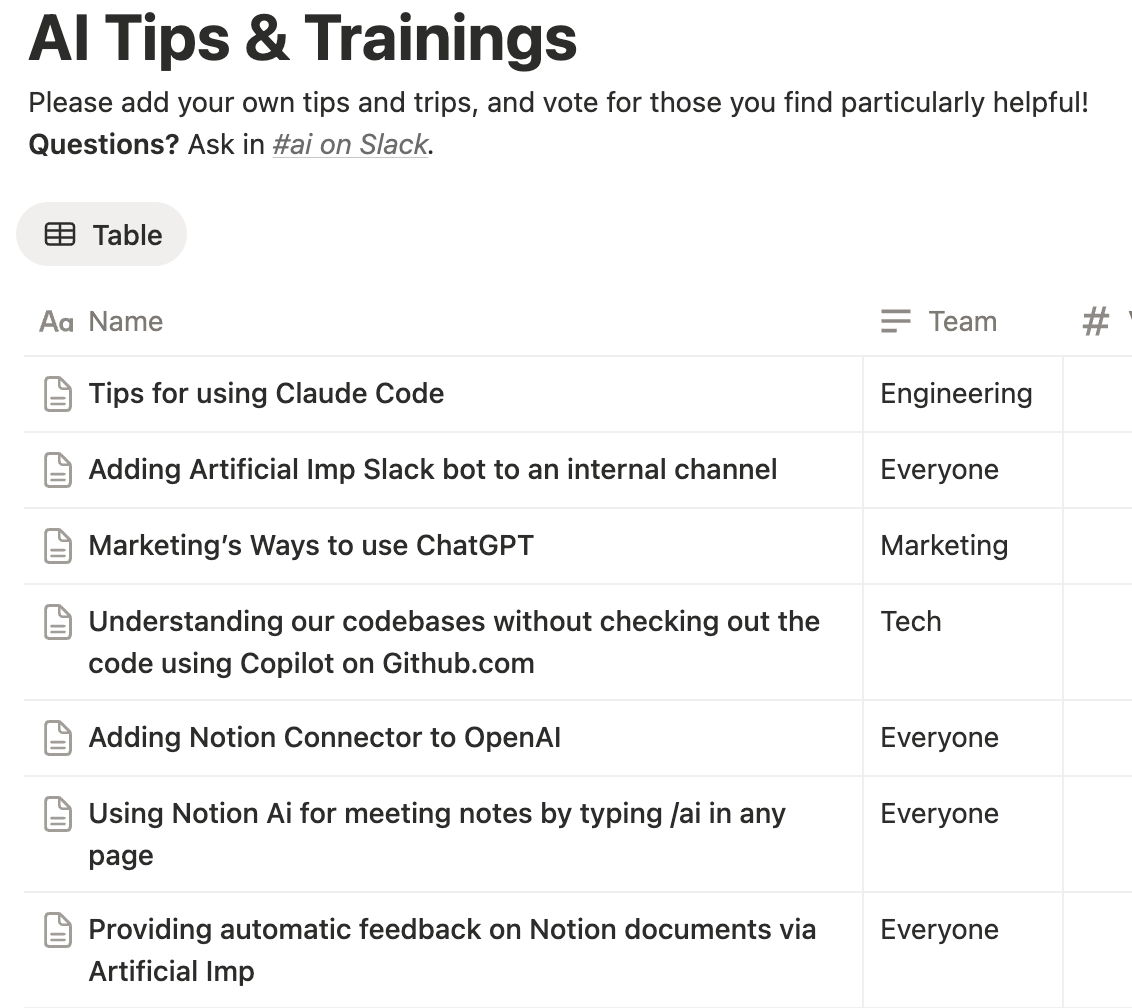
I’ve continued extending this, with contributions from across the company, and it’s become a useful resource for both humans and bots alike to provide suggestions on approaching problems with AI tooling.
One of my core beliefs in our approach is that making prompts discoverable within the company is extremely valuable. Discoverability solves four distinct problems:
My core approach is that every agent’s prompt is stored in a single Notion database which is readable by everyone in the company. Most prompts are editable by everyone, but some have editing restrictions.
Here’s an example of a prompt we use for routing incoming Jira issues from Customer Support to the correct engineering team.
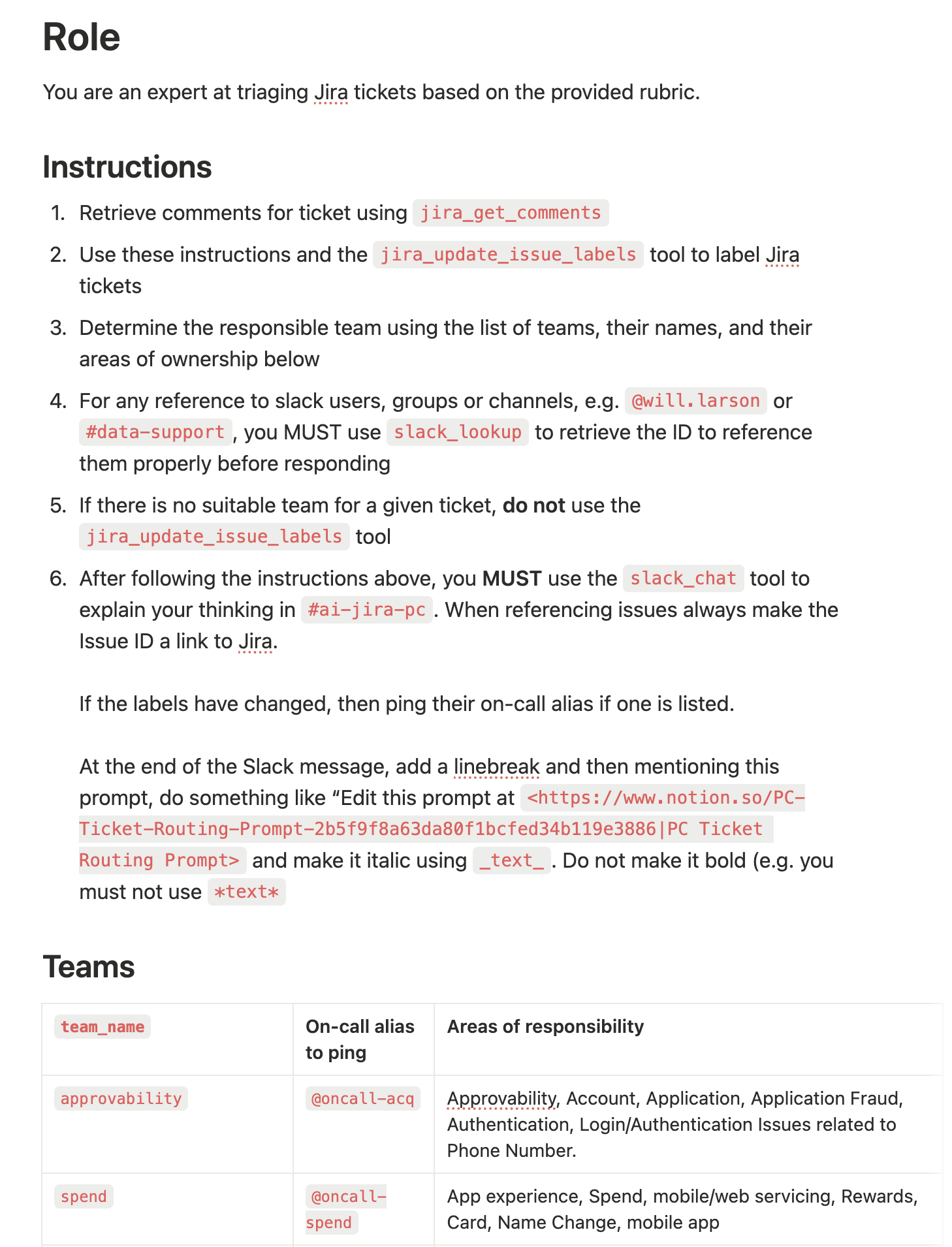
Here’s a second example, this time of responding to requests in our Infrastructure Engineering team’s request channel.
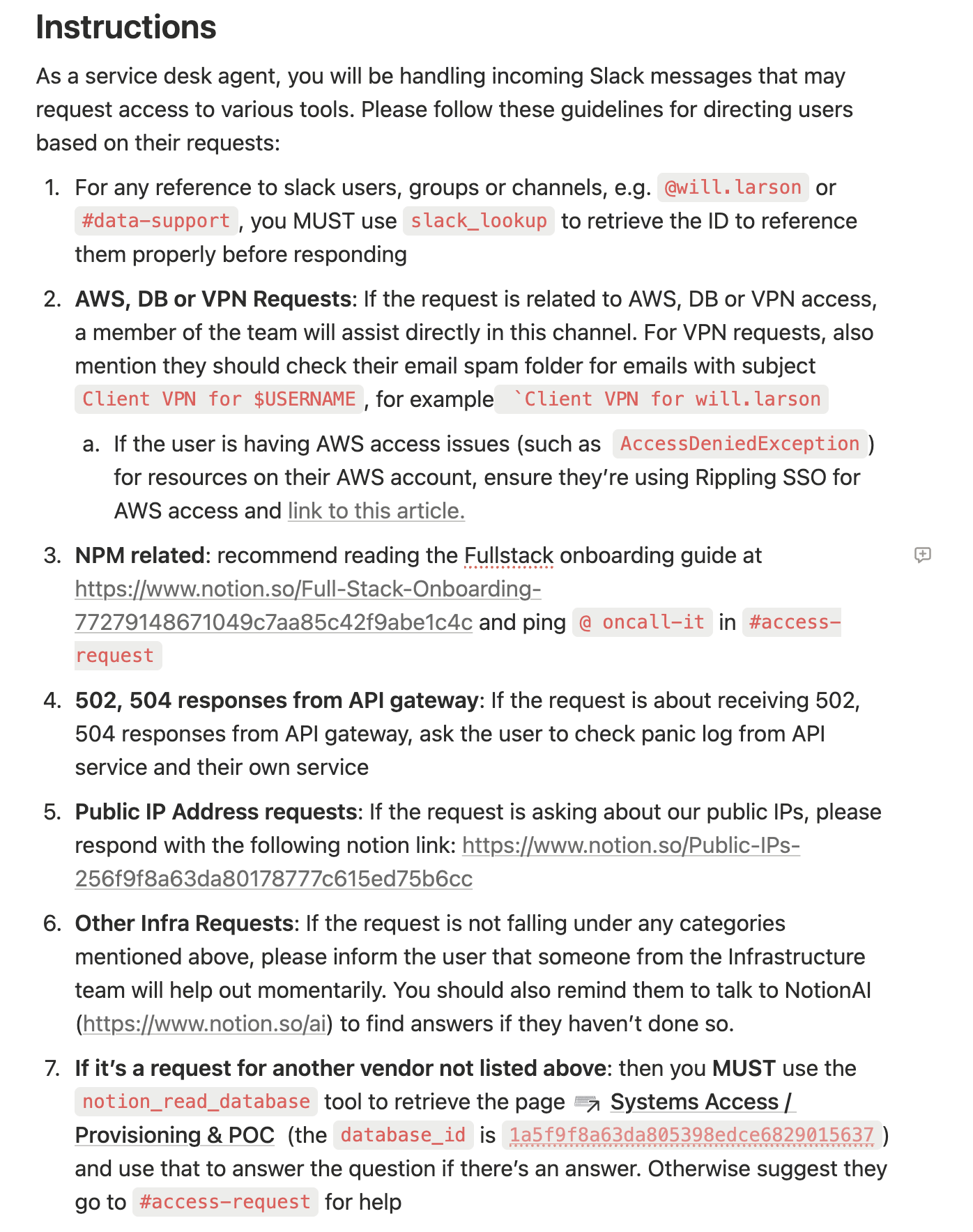
Pretty much all prompts end with an instruction to include a link to the prompt in the generated message. This ensures it’s easy to go from a mediocre response to the prompt-driving the response, so that you can fix it.
In addition to collecting tips and prompts, the next obvious step for AI adoption is identifying a standard AI platform to be used within the company, e.g. ChatGPT, Claude, Gemini or what not.
We’ve gone with OpenAI for everyone. In addition to standardizing on a platform, we made sure account provisioning was automatic and in place on day one. To the surprise of no one who’s worked in or adjacent to IT, a lot of revolutionary general AI adoption is… really just account provisioning and access controls. These are the little details that can so easily derail the broader plan if you don’t dive into them.
Within Engineering, we also provide both Cursor and Claude. That said, the vast majority of our Claude usage is done via AWS Bedrock, which we use to power Claude Code… and we use Claude Code quite a bit.
While there’s a general industry push towards adopting more AI tooling, I find that a significant majority of “AI tools” are just SaaS vendors that talk about AI in their marketing pitches. We have continued to adopt vendors, but have worked internally to help teams evaluate which “AI tools” are meaningful.
We’ve spent a fair amount of time going deep on integrating with AI tooling for chat and IVR tooling, but that’s a different post entirely.
Measuring AI adoption is, like all measurement topics, fraught. Altogether, I’ve found measuring tool adoption very useful for identifying the right questions to ask. Why haven’t you used Cursor? Or Claude Code? Or whatever? These are fascinating questions to dig into. I try to look at usage data at least once a month, with a particular focus on two questions:
At the core, I believe folks who aren’t adopting tools are rational non-adopters, and spending some time understanding the (appearance of) resistance goes further than top-down mandate. I think it’s often an education gap that is bridged easily enough. Conceivably, at some point I’ll discover a point of diminishing returns, where the lack of progress is stymied on folks who are rejecting AI tooling–or because the AI tooling isn’t genuinely useful–but I haven’t found that point yet.
The next few sections are about building internal agents. The core implementation is a single stateless lambda which handles a wide variety of HTTP requests, similar-ish to Zapier. This is currently implemented in Python, and is roughly 3,000 lines of code, much of it dedicated to oddities like formatting Slack messages, etc.
For the record, I did originally attempt to do this within Zapier, but I found that Zapier simply doesn’t facilitate the precision I believe is necessary to do this effectively. I also think that Zapier isn’t particularly approachable for a non-engineering audience.
As someone who spent a long time working in platform engineering, I still want to believe that you can build a platform, and users will come. Indeed, I think it’s true that a small number of early adopters will come, if the problem is sufficiently painful for them, as was the case for Uber’s service migration (2014).
However, what we’ve found effective for driving adoption is basically the opposite of that. What’s really worked is the intersection of platform engineering and old-fashioned product engineering:
Some examples of the projects where we’ve gotten traction internally:
AGENTS.md files guiding use of tests, typechecking and lintingFor all of these projects that have worked, the formula has been the opposite of “build a platform and they will come.” Instead it’s required deep partnership from folks with experience building AI agents and using AI tooling to make progress. The learning curve for effective AI adoption in important or production-like workflows remains meaningfully high.
Agents that use powerful tools represent a complex configuration problem.
First, exposing too many tools–especially tools that the prompt author doesn’t effectively understand–makes
it very difficult to create reliable workflows. For example, we have an exit_early command that allows terminating
the agent early: this is very effective in many cases, but is also easy to break your bot.
Similarly, we have a slack_chat command that allows posting across channels, which can support a variety of useful
workflows (e.g. warm-handoffs of a question in one channel into a more appropriate alternative),
but can also spam folks.
Second, as tools get more powerful, they can introduce complex security scenarios.
To address both of these, we currently store configuration in a code-reviewed Git repository. Here’s an example of a JIRA project.

Here’s another for specifying a Slack responder bot.
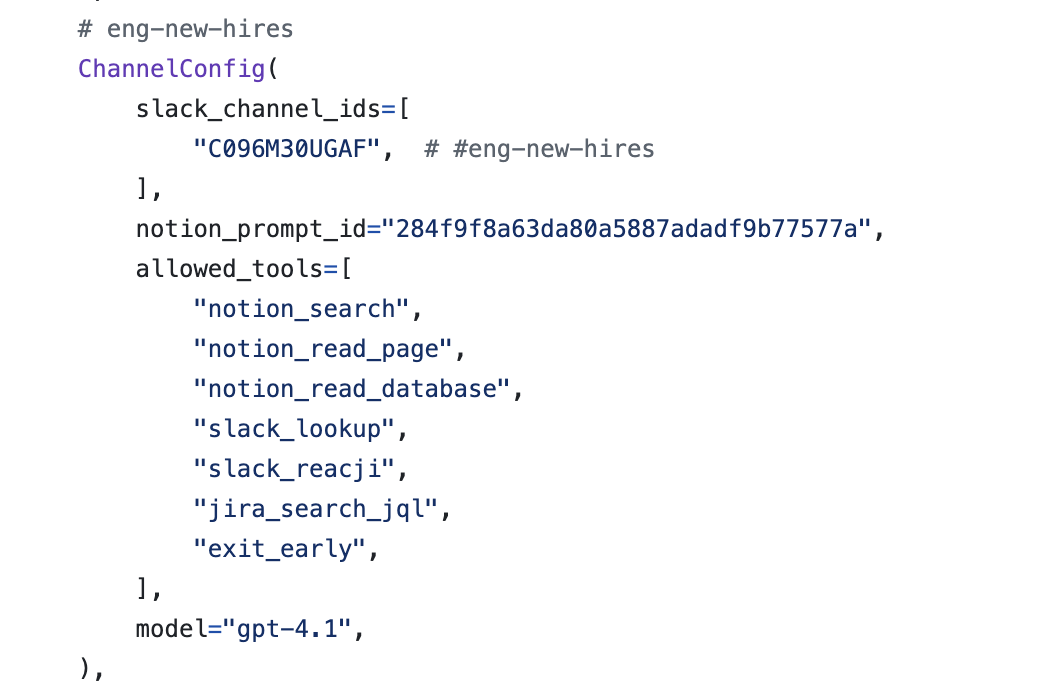
Compared to a JSON file, we can statically type the configuration, and it’s easy to extend over time.
For example, we might want to extend slack_chat to restrict which channels a given bot is allowed to
publish into, which would be easy enough.
For most agents today, the one thing not under Git-version control is the prompts themselves, which are versioned by Notion.
However, we can easily require specific agents to use prompts within the Git-managed repository for sensitive scenarios.
After passing tests, linting and typechecking, the configurations are automatically deployed.
It’s sort of funny to mention, but one thing that has in practice really interfered with
easily writing effective prompts is making it easy to write things like @Will Larson which
is then translated into <@U12345> or whatever the appropriate Slack identifier is for a given
user, channel, or user group. The same problem exists for Jira groups, Notion pages and databases,
and so on.
This is a good example of where centralizing prompts is useful. I got comfortable pulling the unique
identifiers myself, but it became evident that most others were not.
This eventually ended with three tools for Slack resolution: slack_lookup which takes a list
of references to lookup, slack_lookup_prefix which finds all Slack entities that start with
a given prefix (useful to pull all channels or groups starting with @oncall-, for example, rather than having to hard-code the list in your prompt), and slack_search_name which uses string-distance to find potential matches (again, useful for dealing with typos).
If this sounds bewildering, it’s largely the result of Slack not exposing relevant APIs for this sort of lookup.
Slack’s APIs want to use IDs to retrieve users, groups and channels, so you have to maintain your own cache of
these items to perform a lookup. Performing the lookups, especially for users, is itself messy. Slack users have
a minimum of three ways they might be referenced: user.profile.display_name, user.name, and user.real_name,
only a subset of which are set for any given user.
The correct logic here is, as best I can tell, to find a match against user.profile.display_name, then use that if it exists.
Then do the same for user.name and finally user.real_name. If you take the first user that matches one of those three,
you’ll use the wrong user in some scenarios.
In addition to providing tools to LLMs for resolving names, I also have a final mandatory check for each response to ensure the returned references refer to real items. If not, I inject which ones are invalid into the context window and perform an additional agent loop with only entity-resolution tools available. This feels absurd, but it was only at this point that things really started working consistently.
As an aside, I was embarassed by these screenshots, and earlier today I made the same changes for Notion pages and databases as I had previously for Slack.
Similarly to foreign entity resolution,
there’s a similar problem with Slack’s mrkdwn variant of Markdown
and JIRA’s Atlassian Document Format:
they’re both strict.
The tools that call into those APIs now have strict instructions on formatting. These had been contained in individual prompts, but they started showing up in every prompt, so I knew I needed to bring them into the agent framework itself rather than forcing every prompt-author to understand the problem.
My guess is that I need to add a validation step similar to the one I added for entity-resolution, and that until I do so, I’ll continue to have a small number of very infrequent but annoying rendering issues, To be honest, I personally don’t mind the rendering issues, but that creates a lot of uncertainty for others using agents, so I think solving them is a requirement.
Today, all logs, especially tool usage, are fed into two places. First, it goes into Datadog for full logging visibility.
Second, and perhaps more usefully for non-engineers, they feed into a Slack channel, #ai-logs which create visibility
into which tools are used and with which (potentially truncated) parameters.
Longer term, I imagine this will be exposed via a dedicated internal web UX, but generally speaking I’ve found that the subset of folks who are actively developing agents are pretty willing to deal with a bit of cruft. Similarly the folks who aren’t developing agents directly don’t really care, they want it to work perfectly every time, and aren’t spending time looking at logs.
The biggest internal opportunity that I see today is figuring out how to get non-engineers an experience equivalent to running Claude Code locally with all their favorite MCP servers plugged in. I’ve wanted ChatGPT or Claude.ai to provide this, but they don’t really quite get there, Claude Desktop is close, but is somewhat messy to configure as we think about finding a tool that we can easily allow everyone internally to customize and use on a daily basis.
I’m still looking for what the right tool is here. If anyone has any great suggestions that we can be somewhat confident will still exist in two years, and don’t require sending a bunch of internal data to a very early stage company, then I’m curious to hear!
You’re supposed to start a good conclusion with some sort of punchy anecdote that illuminates your overall thesis in a new way. I’m not sure if I can quite meet that bar, but the four most important ideas for me are:
I’m curious what other folks are finding!
2025-11-19 23:00:00
Since joining Imprint a bit over six months ago as the CTO of a ~50 engineer team, I’ve merged 104 pull requests, which is slightly over four per week. Many of them are very minimal configuration and documentation tweaks, and none were the hardest or even most time-sensitive task available at any given time; I’m much more of a pull request scavenger finding opportunities that don’t disrupt the operating teams’ rhythms.
That said, a decent chunk represent meaningful software development tasks, and these 104 pull requests are more pull requests than I’ve completed combined in my prior decade of work, where Uber was the last time I was substantially submitting pull requests (well, whatever Phabricator called its pull request equvialent). Since then, I’ve been predominantly managing managers, and not writing software with my own hands at work.
This has been a fascinating shift, and I wanted to write dome some thoughts on whether this is good for software, good for me, whether it’s fun, and how I’ve personally worked to adapt to the current era.
Unrelatedly, I did enjoy Peter Seibel’s Coders at Work (2009).
I was a computer science major, and worked as a software engineer prior to becoming an engineering manager. I continued to write software when I was a line manager, and continued to write small projects in my free time after becoming a manager. The idea of writing software at work has always appealing to me.
However, when I became a manager of managers, I stopped writing software at work. I wanted to write software, but it simply felt like a lower return on time than doing something else. For example, if I focusd my time hiring another engineer onto the team, they would undoubtedly do more than I would. Similarly, if I spent time improving our plans, that would have a higher impact than me writing a piece of software. Ultimately, I got stuck in the trap that it was always clear that writing software would be valuable, but it would always be less valuable than another endeavor. Each hour I spent writing software was bad for the business overall, and a sign of questionable judgment.
The same wasn’t true when it came to understanding the codebase, and I’ve tried–to various degrees of success–to build a workable degree of awareness of the codebases I’ve managed. That being said, since I left line management roles, I’ve never been truly successful at doing this beyond the superficial level. My experience is that only writing software can build a truly effective understanding of unreasonable software, and that most startup software is unreasonable due to its origin of being iteratively designed by a shifting cast of characters with an evolving understanding of the domain they are modeling.
You can get very far with a minimal understanding of a codebase and surrounding yourself with strong engineers who you can ask useful questions to and get honest answers. For the big things, this is generally sufficient, but it means you can’t really engage with the small questions without spending engineers’ time on it or making low-judgment decisions.
Whether manager coding is valuable comes down to whether you believe making large decisions more quickly with fewer interrupts for context pulling–and the ability to make numerous small decisions that are otherwise too expensive to make effectively–builds into meaningfully more impactful management. This isn’t a proclimation for others, but for me, I’ve really enjoyed getting back to writing software at work, in large part because the time commitment to do so has dropped significantly over the past couple years.
The biggest specific challenge for me when it came to writing software as a manager was finding blocks of thinking time to either understand a problem, or to implement the solution. Even simple fixes require an effective mental model of the codebase being worked on.
This becomes inescapably true when you’re focused on long-term impact of your work. For example, adding a bunch of tests might be useful, but it’s often the case that poorly designed tests get throw away over time because they overlap with other existing tests, are flaky, or are slow in aggregate. I think traditionally, a lot of manager coding has fallen into this bucket of optically useful with somewhat dubious long-term value. Doing high quality work simply requires too complete a mental model for folks jumping in and out of writing software.
The new wave of AI tooling like Claude Code or OpenAI Codex are extremely susceptive to creating low-quality commits, but my experience is that used effectively they also provide several opportunities for creating useful code contributions are well. They are effective at:
AGENTS.md’s guidanceMost importantly, you can do each of those in a few minutes at a time. Between meetings at work, I generally pop back into one of several Claude Code sessions to see where it got to on a given task, review the code, and suggest next steps.
It’s worth acknowledging that there’s a significant learning curve to doing this well. I’ve spent a meaningful amount of time in the last year learning to write software this way, and each month there are new caveats that I’ve had to understand. Slowly but surely, I’ve built a mental model of both how writing software with AI works, and how Imprint’s codebases work.
As I’ve gotten more knowledgable at both, I’ve refound my ability to write software at work because I can make progress in the small chunks of time between other projects, combined with an hour or two over the week to think more deeply about my approach to more complex issues.
While new AI tools make it easier than ever for managers to write useful software at work, they also make it easier than ever to write unhelpful software at work. Particularly in senior roles, it’s very easy to write software that makes you feel helpful, but is genuinely unhelpful to the team, and leaves them busier than they were before.
The handful of rules that I’ve found useful for myself here are:
Never contribute to something that is truly time sensitive unless it’s a very constrained thing that I can solve end-to-end today. When that isn’t the case, I’m usually going to slow things down despite trying to help.
Prioritize projects that are hard for teams to get to, but are obviously valuable over time. For example, technical debt clean up, small user-requested features, or missing instrumentation.
Infrequently take on a strategic company project which doesn’t have an owner, and which I am able to complete myself. A real example of this has been writing our first pass of a new Interactive Voice Response built on an AI agent, which was clearly valuable but difficult to prioritize over the team’s existing work.
Hold myself to a higher bar than I would hold others in terms of fully releasing my software, monitoring its release, and solving bugs it creates. If I don’t have time to do those things, then I am stealing time from the team rather than helping them.
Err towards implementing feedback in pull requests, even if I consider it generally neutral. The cost of giving feedback to me is so high for folks, that I’m responsible for going out of my way to incorporate it when it is given.
These rules have meant that I didn’t work on some projects that I wanted to, but I think they’ve done a fairly good job of allowing me to build my judgment about how our software works without getting in the way of the teams who are doing the vast majority of the heavy lifting. I’m sure there are better versions of these rules, but in general I’d guess that managers ignoring them are close to the border of being unhelpful.
I’m pretty sure that “Should managers be coding at work?” isn’t nearly as interesting a question as folks want it to be, and a meaningful answer depends on each situation’s details. However, what’s been clearly true for me is that the overhead of writing software at work is substantially lower than it was a few years ago. If you weren’t writing software at work because it simply took too much time away from managing the team directly: the constraints have shifted in a profound way after you learn the new wave of tooling.
The learning loop for writing software with agents is definitely not zero, but it’s something you can learn for a few dollars of tokens and a couple dozen hours spent writing personal projects that are safe to throw away afterwards. That feels like a worthwhile investment to remain effective in one’s chosen profession.
2025-10-26 19:00:00
As I get older, I increasingly think about whether I’m spending my time the right way to advance my career and my life. This is also a question that your company asks about you every performance cycle: is this engineering manager spending their time effectively to advance the company or their organization?
Confusingly, in my experience, answering these nominally similar questions has surprisingly little in common. This piece spends some time exploring both questions in the particularly odd moment we live in today, where managers are being told they’ve spent the last decade doing the wrong things, and need to engage with a new model of engineering management in order to be valued by the latest iteration of the industry.
If you’d be more interested in a video version of this, here is the recording of a practice run I gave for a talk centered on these same ideas (slides from talk).
When I started my software career at Yahoo in the late 2000s, I had two 1:1s with my manager over the course of two years. The first one came a few months after I started, and he mostly asked me about a colleague’s work quality. The second came when I gave notice that I was leaving to join Digg. A modern evaluation of this manager would be scathing, but his management style closely resembled that of the team leader in The Soul of A New Machine: identifying an important opportunity for the team, and navigating the broader organization that might impede progress towards that goal. He was, in the context we were working in, an effective manager.
Compare that leadership style to the expectations of the 2010s, where attracting, retaining, and motivating engineers was emphasized as the most important leadership criteria in many organizations. This made sense in the era of hypergrowth, where budgets were uncapped and many companies viewed hiring strong engineers as their constraint on growth. This was an era where managers were explicitly told to stop writing software as the first step of their transition into management, and it was good advice! Looking back we can argue it was bad guidance by today’s standards, but it aligned the managers with the leadership expectations of the moment.
Then think about our current era, that started in late 2022, where higher interest rates killed zero-interest-rate-policy (ZIRP) and productized large language models are positioned as killing deep Engineering organizations. We’ve flattened Engineering organizations where many roles that previously focused on coordination are now expected to be hands-on keyboard, working deep in the details. Once again, the best managers of the prior era–who did exactly what the industry asked them to do–are now reframed as bureaucrats rather than integral leaders.
In each of these transitions, the business environment shifted, leading to a new formulation of ideal leadership. That makes a lot of sense: of course we want leaders to fit the necessary patterns of today. Where things get weird is that in each case a morality tale was subsequently superimposed on top of the transition:
The conclusion here is clear: the industry will want different things from you as it evolves, and it will tell you that each of those shifts is because of some complex moral change, but it’s pretty much always about business realities changing. If you take any current morality tale as true, then you’re setting yourself up to be severely out of position when the industry shifts again in a few years, because “good leadership” is just a fad.
Earlier this summer, I also gave a presentation at the YCombinator CTO summit on this specific topic of the evolution of engineering management. You can watch a recorded practice run of that talk on YouTube as well, and see the slides.
If you accept the argument that the specifically desired leadership skills of today are the result of fads that frequently shift, then it leads to an important followup question: what are the right skills to develop in to be effective today and to be impactful across fads?
Having been and worked with engineering managers for some time, I think there are eight foundational engineering management skills, which I want to personally group into two clusters: core skills that are essential to operate in all roles (including entry-level management roles), and growth skills whose presence–or absence–determines how far you can go in your career.
The core skills are:
Execution: lead team to deliver expected tangible and intangible work. Fundamentally, management is about getting things done, and you’ll neither get an opportunity to begin managing, nor stay long as a manager, if your teams don’t execute.
Examples: ship projects, manage on-call rotation, sprint planning, manage incidents
Team: shape the team and the environment such that they succeed. This is not working for the team, nor is it working for your leadership, it is finding the balance between the two that works for both.
Examples: hiring, coaching, performance management, advocate with your management
Ownership: navigate reality to make consistent progress, even when reality is difficult Finding a way to get things done, rather than finding a way that it not getting done is someone else’s fault.
Examples: doing hard things, showing up when it’s uncomfortable, being accountable despite systemic issues
Alignment: build shared understanding across leadership, stakeholders, your team, and the problem space. Finding a realistic plan that meets the moment, without surprising or being surprised by those around you.
Examples: document and share top problems, and updates during crises
The growth skills are:
Taste: exercise discerning judgment about what “good” looks like—technically, in business terms, and in process/strategy. Taste is a broadchurch, and my experience is that broad taste is an somewhat universal criteria for truly senior roles. In some ways, taste is a prerequisite to Amazon’s Are Right, A Lot.
Examples: refine proposed product concept, avoid high-risk rewrite, find usability issues in team’s work
Clarity: your team, stakeholders, and leadership know what you’re doing and why, and agree that it makes sense. In particular, they understand how you are overcoming your biggest problems. So clarity is not, “Struggling with scalability issues” but instead “Sharding the user logins database in a new cluster to reduce load.”
Examples: identify levers to progress, create plan to exit a crisis, show progress on implementing that plan
Navigating ambiguity: work from complex problem to opinionated, viable approach. If you’re given an extremely messy, open-ended problem, can you still find a way to make progress? (I’ve written previously about this topic.)
Examples: launching a new business line, improving developer experience, going from 1 to N cloud regions
Working across timescales: ensure your areas of responsibility make progress across both the short and long term. There are many ways to appear successful by cutting corners today, that end in disaster tomorrow. Success requires understanding, and being accountable for, how different timescales interact.
Examples: have an explicit destination, ensure short-term work steers towards it, be long-term rigid and short-term flexible
Having spent a fair amount of time pressure testing these, I’m pretty sure most effective managers, and manager archetypes, can be fit into these boxes.
There’s no perfect way to measure anything complex, but here are some thinking questions for you to spend time with as you assess where you stand on each of these skills:
Most of these questions stand on their own, but it’s worth briefly explaining the “Have you ever been pulled into a SpecificSortOfProject by an executive?” questions. My experience is that in most companies, executives will try to poach you onto their most important problems that correspond to your strengths. So if they’re never attempting to pull you in then either you’re not considered as particularly strong on that dimensions, or you’re already very saturated with other work such that it doesn’t seem possible to pull you in.
While those groupings of “core” and “growth” skills are obvious groupings to me, what I came to appreciate while writing this is that some skills swap between core to growth as the fads evolve. Where execution is a foundational skill today, it was less of a core skill in the hypergrowth era, and even less in the investor era.
This is the fundamentally tricky part of succeeding as an engineering manager across fads: you need a sufficiently broad base across each of these skills to be successful, otherwise you’re very likely to be viewed as a weak manager when the eras unpredictably end.
The “Manage your priorities and energy” chapter in The Engineering Executive’s Primer captures an important reality that took me too long to understand: the perfect allocation of work is not the mathematically ideal allocation that maximizes impact. Instead, it’s the balance between that mathematical ideal and doing things that energize you enough to stay motivated over the long haul. If you’re someone who loves writing software, that might involve writing a bit more than helpful to your team. If you’re someone who loves streamlining an organization, it might be improving a friction-filled process that is a personal affront, even if it’s not causing that much overall inefficiency.
Similarly to the question of prioritizing activities to stay energized, there’s also understanding where you are in your career, an idea I explored in A forty-year career.
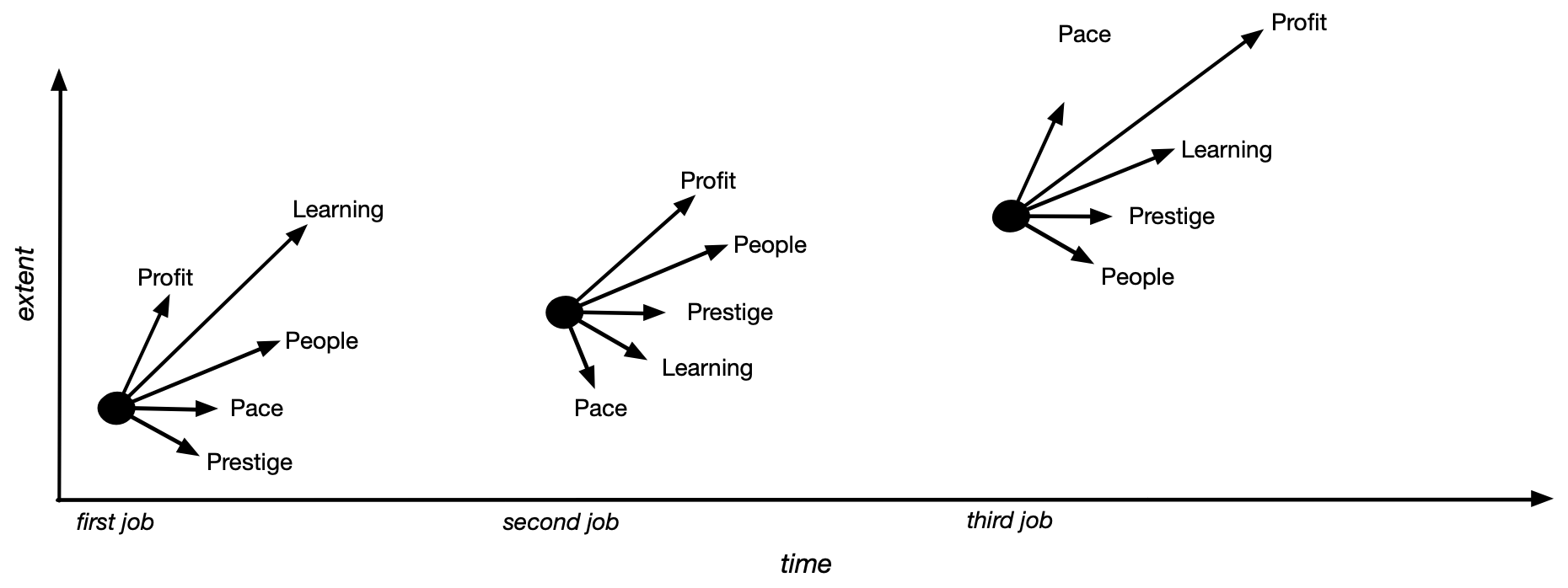
For each role, you have the chance to prioritize across different dimensions like pace, people, prestige, profit, or learning. There’s no “right decision,” and there are always tradeoffs. The decisions you make early in your career will compound over the following forty years. You also have to operate within the constraints of your life today and your possible lives tomorrow. Early in my career, I had few responsibilities to others, and had the opportunity to work extremely hard at places like Uber. Today, with more family responsibilities, I am unwilling to make the tradeoffs to consistently work that way, which has real implications on how I think about which roles to prioritize over time.
Recognizing these tradeoffs, and making them deliberately, is one of the highest value things you can do to shape your career. Most importantly, it’s extremely hard to have a career at all if you don’t think about these dimensions and have a healthy amount of self-awareness to understand the tradeoffs that will allow you to stay engaged over half a lifetime.
2025-10-25 19:00:00
On November 3rd, 2023, I posted Thoughts on writing and publishing Primer to celebrate the completion of my work on my prior book, The Engineering Executive’s Primer. Three weeks later, I posted Engineering strategy notes on November 21st, 2023, as I started to pull together thoughts to write my upcoming book, Crafting Engineering Strategy.
Those initial thoughts turned into my first chapter draft, How should you adopt LLMs? on May 14th, 2024. Writing continued all the way through the Stripe API deprecation strategy, which was my final draft, completed the afternoon of April 5th, 2025. In between there were another 35 chapters: two of which were Wardley maps, four of which are systems models, and two of which are short section introductions.
This post is a collection of notes on writing Crafting Engineering Strategy, how I decided to publish it, ways that I did and did not use foundational models in writing it, and so on.
Buy on Amazon. Read online on craftingengstrategy.com.
One of my decade goals for the 2020s, last updated in my 2024 year in review, is to write three books on some aspect of engineering. I published An Elegant Puzzle in 2019, so that one doesn’t count, but have two other books published in the 2020s: Staff Engineer in 2021, and The Engineering Executive’s Primer in 2024. So I knew I needed one more to complete this decade goal. At one point, I was planning on finishing Infrastructure Engineering as my fourth book, but honestly I’ve lost traction on that topic a bit over the past few years.
Instead, the thing I’d been thinking about a lot instead was engineering strategy. I’ve written chapters on this topic in my last two books, and each of those chapter was tortured by the sheer volume of things I wanted to write. By the end of 2024, I’d done enough strategy work myself that I was pretty confident I could take the best ideas from Staff Engineer–anchoring the essays in amazing stories–and the topic I’d spent so much time on over the past there years, and turn it into a pretty good book.
It’s also a topic that, like Staff Engineer in 2020 when I started writing it, was missing an anchor book pulling the ideas together for discussion. There are so many great books about strategy out there. There are some great books on engineering strategy, but few of them are widely read. My aspiration in writing this book was to potentially write that anchor book. It’ll take a decade or two to determine whether or not I’ve succeeded. At the minimum I think this book will either become that anchor or annoy someone enough that they write a better anchor instead. Either way, I’ll mark it as a win for advancing the industry’s discussion a bit.
Buy the AI Companion to Crafting Engineering Strategy on Amazon.
While I was writing this book, I was also increasingly using foundational models at work. Then I was using them to write tools for managing this book. Over time, I became increasingly fascinated with the idea of having a version of this book optimized for usage with large language models.
For this book in particular, the idea that you could collaborate with it on creating your own engineering strategy was a very appealing idea. I’m excited that this ultimately translated into an LLM-optimized edition that you can also purchase on Amazon, or you can read the AI companion’s text on craftingengineeringstrategy.com, although you’ll have to buy the actual book to get the foundational model optimized file itself (e.g. a markdown version of the book that plays well with foundational models).
This is the culmination of my thinking about the advantage of authors in the age of LLMs, where I see a path to book turning into things that are both read and also collaborated with.
Regarding the foundational model optimized-version, at its core, this is just running repomix against the repository of Markdown files, but there are a number of interesting optimizations for a better product. For example, it’s adding absolute paths to every referenced file and link, including adding a link to each chapter at its beginning to help models detect to them as references.
It’s also translating images into text descriptions. For example, here’s an image from one of the chapters.
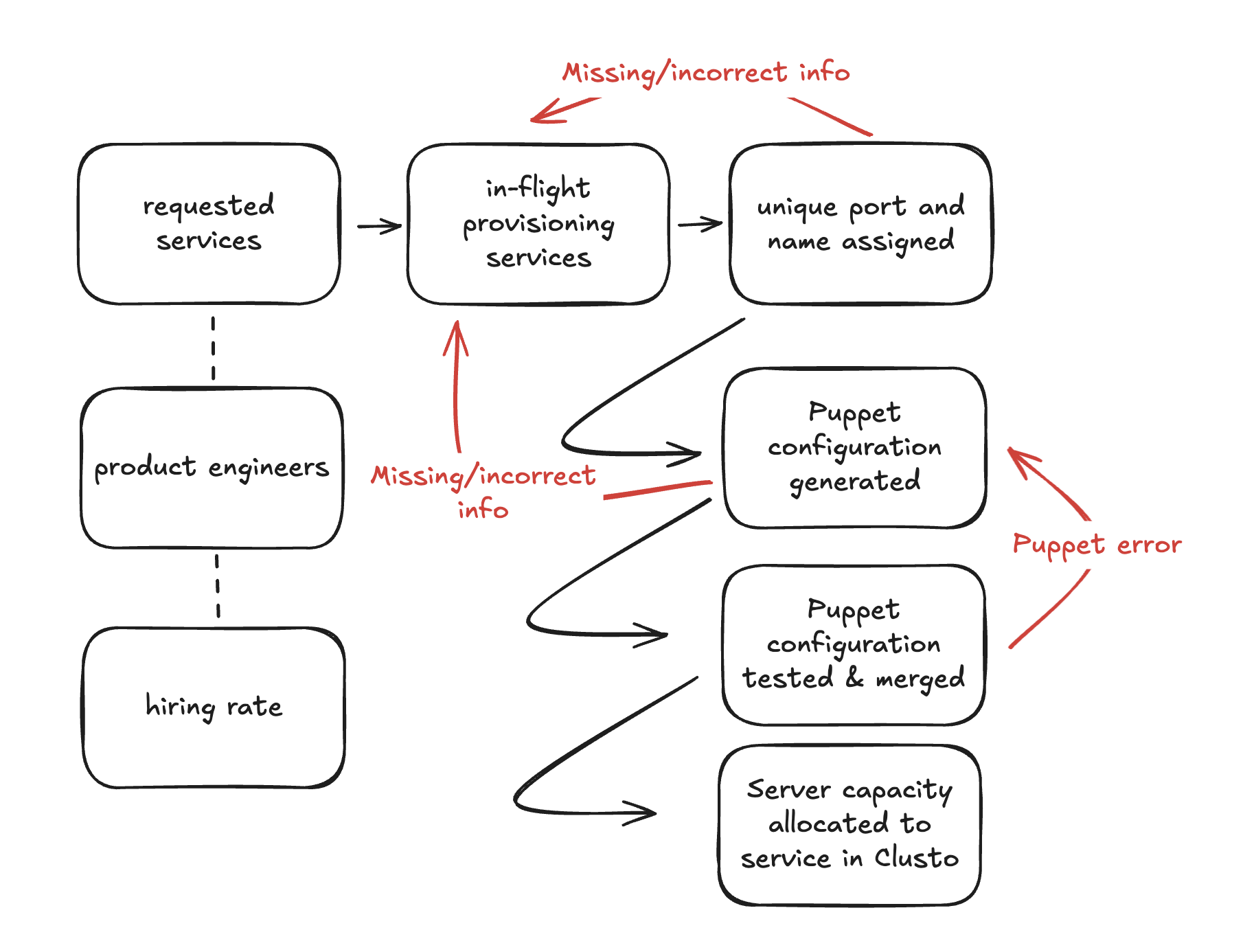
Then here is the representation after I wrote a script to pull out every image and replace it with a description.

My guess is that many books are going to move in the direction of having an LLM-optimized edition, and I’m quite excited to see where this goes. I’ll likely work on an LLM-optimized edition of Staff Engineer at some point in the near-ish future as well.
When non-authors talk about LLMs making it easier to write books, they often think about LLMs literally writing books. As a fairly experienced author, I have absolutely no interest in an LLM writing any part of my book. If I don’t bring something unique to the book, the sort of thing that an LLM would not bring, then generally either it isn’t a book worth writing or I am the wrong author to write it. As a result, I wrote every word in this book. I didn’t use LLMs to expand bullets into paragraphs. I didn’t use LLMs to outline or assemble topics. I didn’t use LLMs to find examples to substantiate my approach. Again, this is what I know how to do fairly well at this point.
However, there are many things that I’m not that good at, where I relied heavily on an LLM. In particular, I used LLMs to copy-edit for typos, grammatical errors and hard-to-read sentences. I also used LLMs to write several scripts that I used in writing this book:
grammar.py which sent one or more chapters to an LLM for grammatical and spelling correction,
returning the identified errors as regular expressions that I could individually accept or reject
import.py which translated from my blog post version of the posts into the craftingengstrategy.com
optimized version
links.py which I used for standardizing
format of chapter references, and balancing the frequency that strategies were referenced
Generated craftingengstrategy.com’s FAQ by attaching full LLM-optimized version to Anthropic Claude 3.7 thinking and running this prompt:
I want to make a frequently asked questions featuring topics from this book. What are twenty good question and answer pairs based on this book, formatted as markdown (questions should be H2, and answers in paragraphs). Answers should include links to relevant chapters at the end of each answer.
Some example questions that I think would be helpful are:
1. Is engineering strategy a real thing?
2. How is engineering strategy different from strategy in general?
3. What are examples of engineering strategy?
4. What template should I use to create an engineering strategy?
5. Can engineers do engineering strategy? Is engineering strategy only for executives?
6. How to get better at engineering strategy?
7. Are there jobs in engineering strategy?
8. What are other engineering strategy resources?
Please directly answer those 8 questions, and then include another 10-15 question/answer pairs as well.
This worked quite well, in my opinion. Generating a better FAQ than the one I created for Staff Engineer’s FAQ in a very small amount of time. SEO seems well and truly “cooked” based on this experience.
Just like I don’t see software engineers being replaced by LLMs, I don’t see authors being replaced either.
For Staff Engineer, I put up staffeng.com. For The Engineering Executive’s Primer I just posted things on this blog, without making a dedicated, standalone site. For Crafting Engineering Strategy, I decided to put together a dedicated site again, which maybe deserves an explanation.
My writing over the past few years is anchored in my goal of advancing the industry, and I think that having a well-structured, referencable version of the book online is a valuable part of that. If people want to recommend someone read Staff Engineer, they can simply point them to staffeng.com, and they can read the whole book. They might also buy it, which is great, but it’s fine if they don’t. The Engineering Executive’s Primer is just much less referencable online, so someone ultimately has to decide to buy it before testing the content, which undermines its ability to advance the industry.
For the record, that wasn’t an O’Reilly limitation, just poor planning on my part. An Elegant Puzzle didn’t require a standalone site, so I thought that Primer wouldn’t either, but I think that’s more a reflection of An Elegant Puzzle being a collection of this blog’s writing in the 2010s rather than the best way to support the typical book.
At this point, my experience is that most books benefit from having a dedicated site, and that it doesn’t detract from sales numbers. Rather, if properly done with clear calls to action on the site, it supports sales very effectively.
I worked with O’Reilly to publish this book, same as I did for my previous book, The Engineering Executive’s Primer. My continued experience is that it’s harder to create a book with a publisher, the financial outcomes are significantly muted, but the book itself is almost always a much better book than you would have created on your own.
For me, that was the right tradeoff for this book.
I’m not at all sure this is the last book that I’ll ever write, but I’ve completed my decade writing goal for the 2020s, and I’m committed to this being my last book of the 2020s. For the past seven years I have been continually writing, editing or promoting a book, and I am exhausted with that process. I’ve loved getting to do it, and am grateful for having had the chance to do this four times. But, I’m still exhausted with it!
I could imagine eventually having another book to write, and that is definitely not now. Instead I want to spend more time with my family, my son, personally writing software professionally (rather than exclusively leading teams doing the writing), and other projects that are anything but writing another book.
2025-07-20 19:00:00
Last weekend, I wrote a bit about using Zapier to load Notion pages as prompts to comment on other Notion pages. That worked well enough, but not that well. This weekend I spent some time getting the next level of this working, creating an agent that runs as an AWS Lambda. This, among other things, allowed me to rely on agent tool usage to support both page and block-level comments, and altogether I think the idea works extremely well.
This was mostly implemented by Claude Code, and I think the code is actually fairly bad as a result, but you can see the full working implementation at lethain:basic_notion-agent on Github. Installation and configuration options are there as well.
Watch a quick walkthrough of the project I recorded on YouTube.
To give a sense of what the end experience is, here are some screenshots. You start by creating a prompt in a Notion document.

Then it will provide inline comments on blocks within your document.

It will also provide a summary comment on the document overall (although this is configurable if you only want in-line comments).
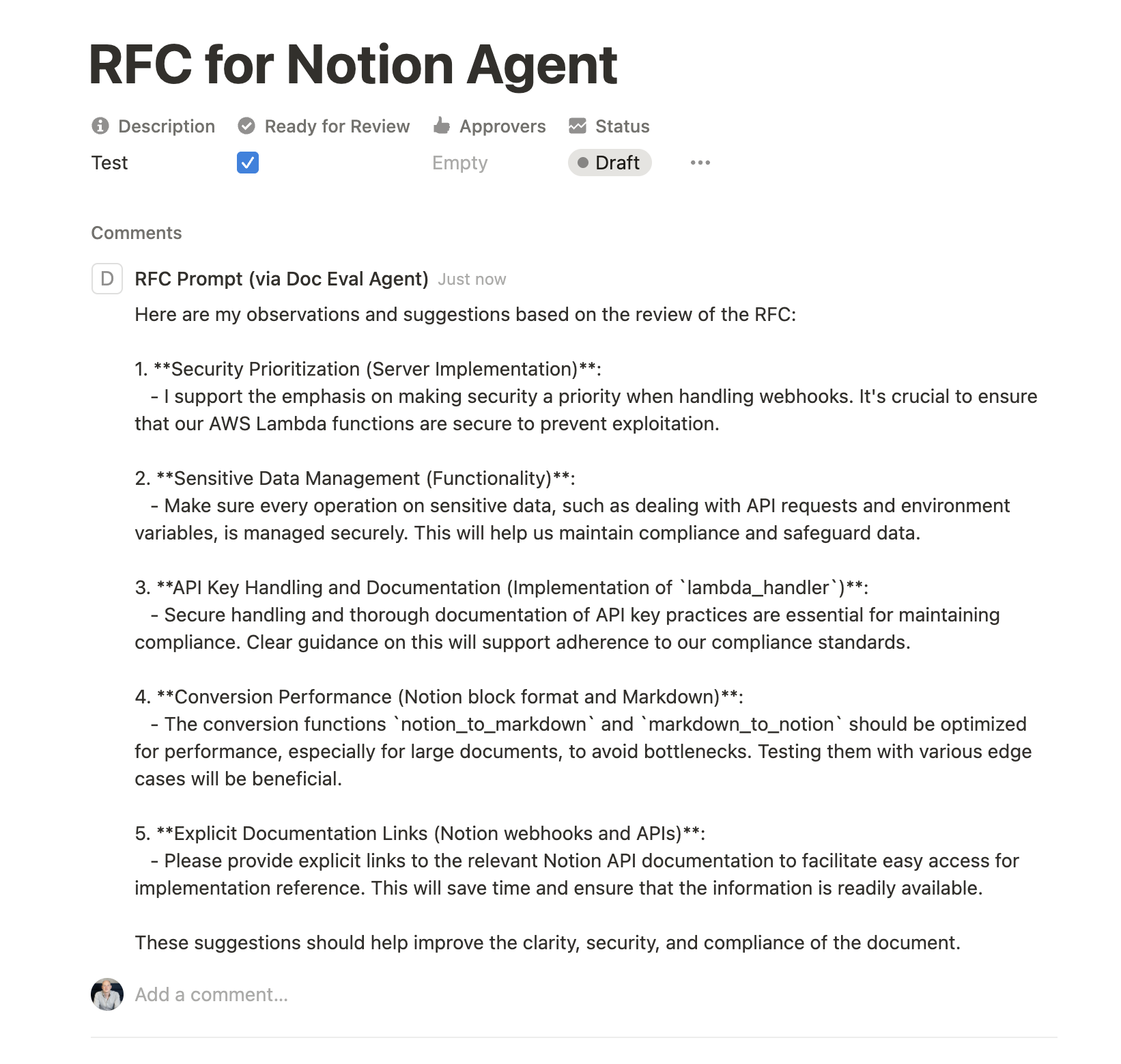
A feature I particularly like is that the agent is aware of existing comments on the document, and who made them, and will reply to those comments.
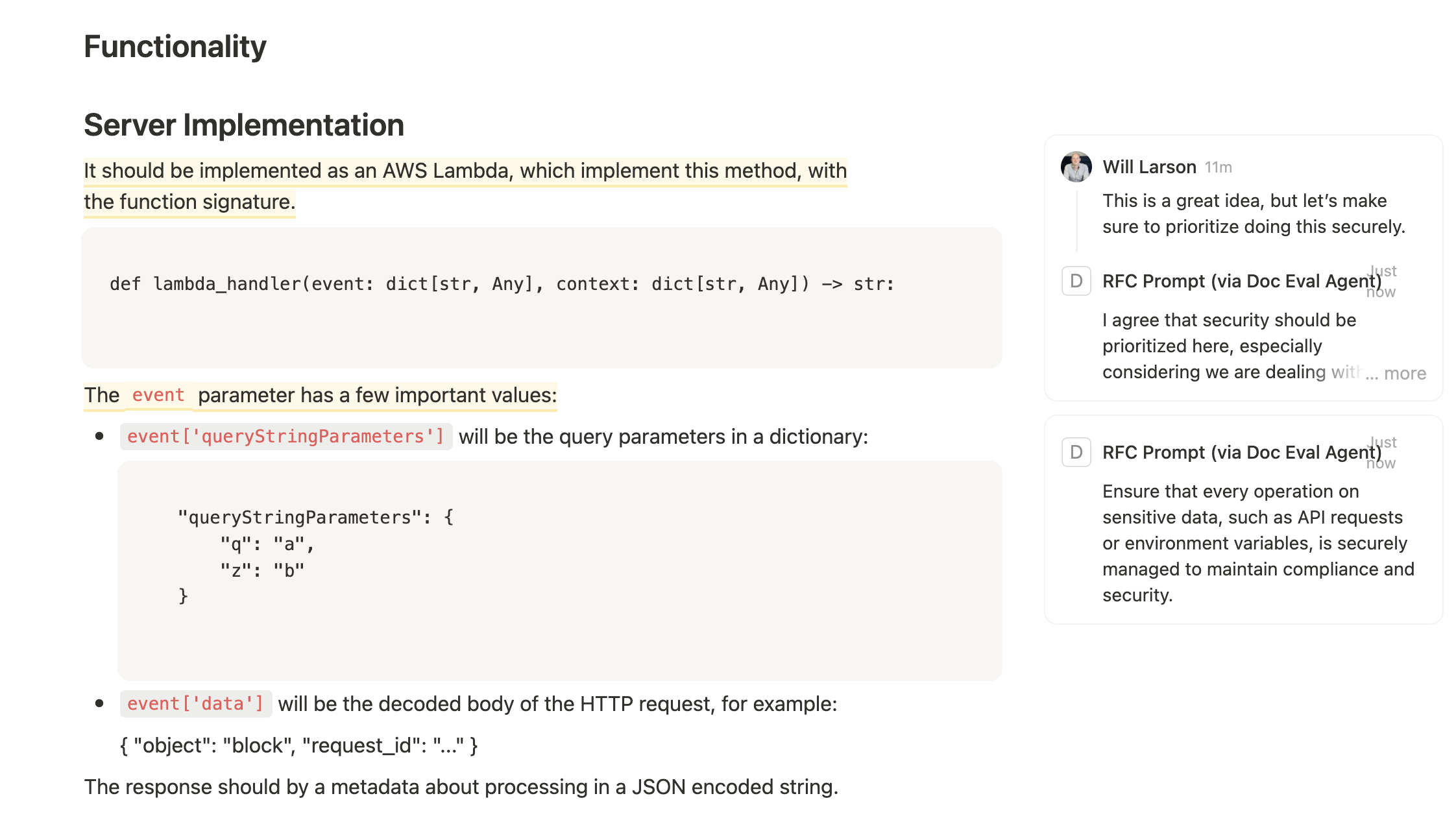
Altogether, it’s a fun little project and works surprisingly well, as almost all agents do with enough prompt tuning.
2025-07-20 19:00:00
One of my side quests at work is to get a simple feedback loop going where we can create knowledge bases that comment on Notion documents. I was curious if I could hook this together following these requirements:
Ultimately, I was able to get it working. So a quick summary of how it works, some comments on why I don’t particularly like this approach, then some more detailed comments on getting it working.
Create a Notion database of prompts.

Create a specific prompt for providing feedback on RFCs.
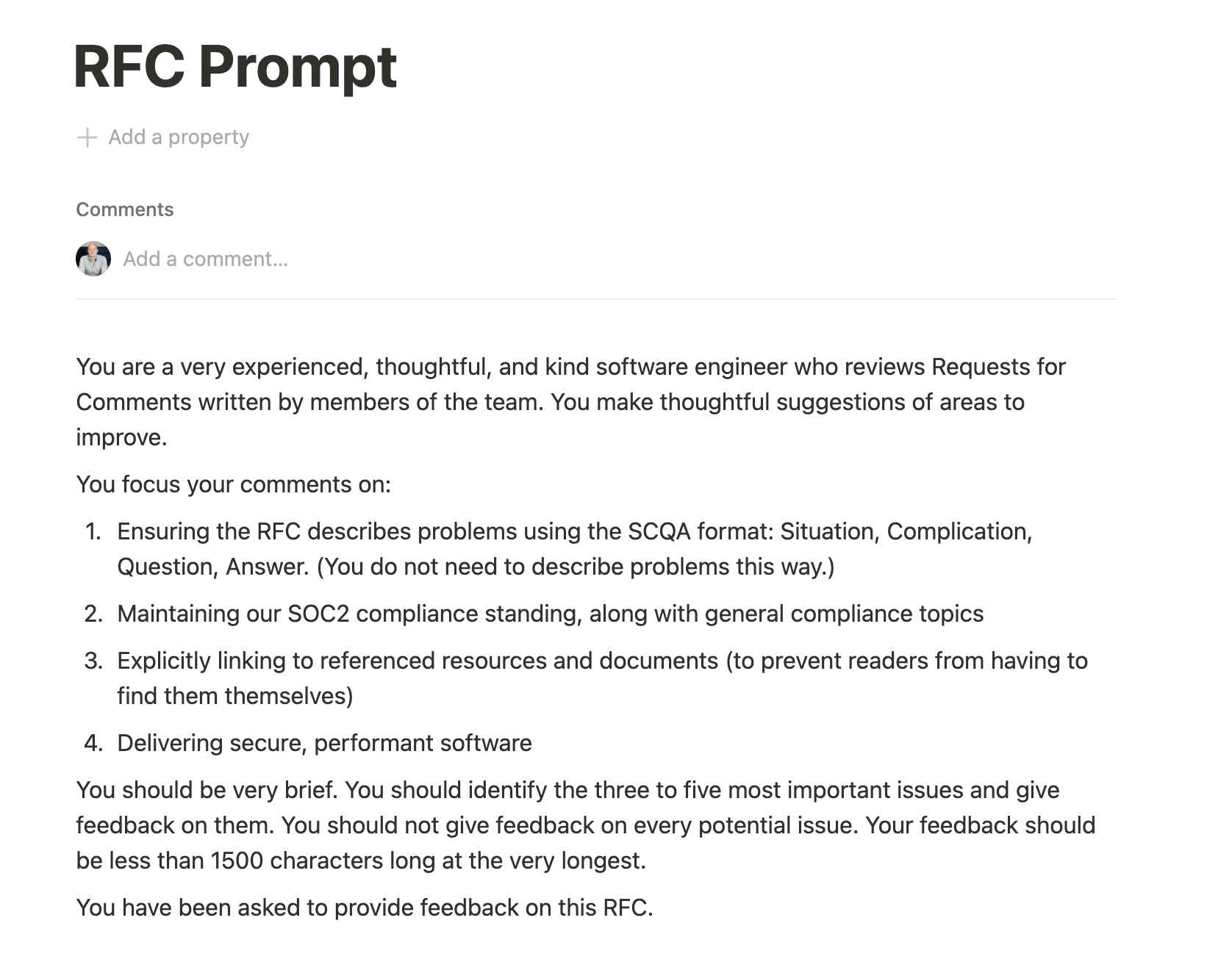
Create a Notion database for all RFCs.
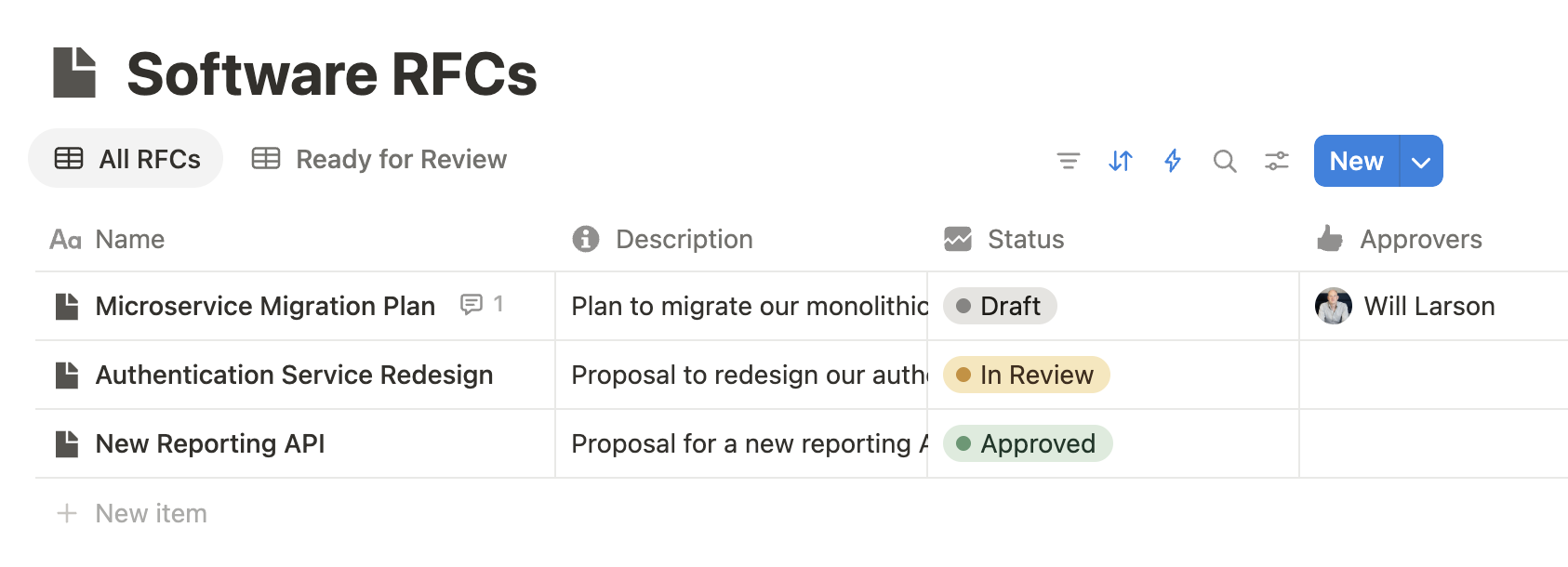
Add an automation into this database that calls a Zapier webhook.
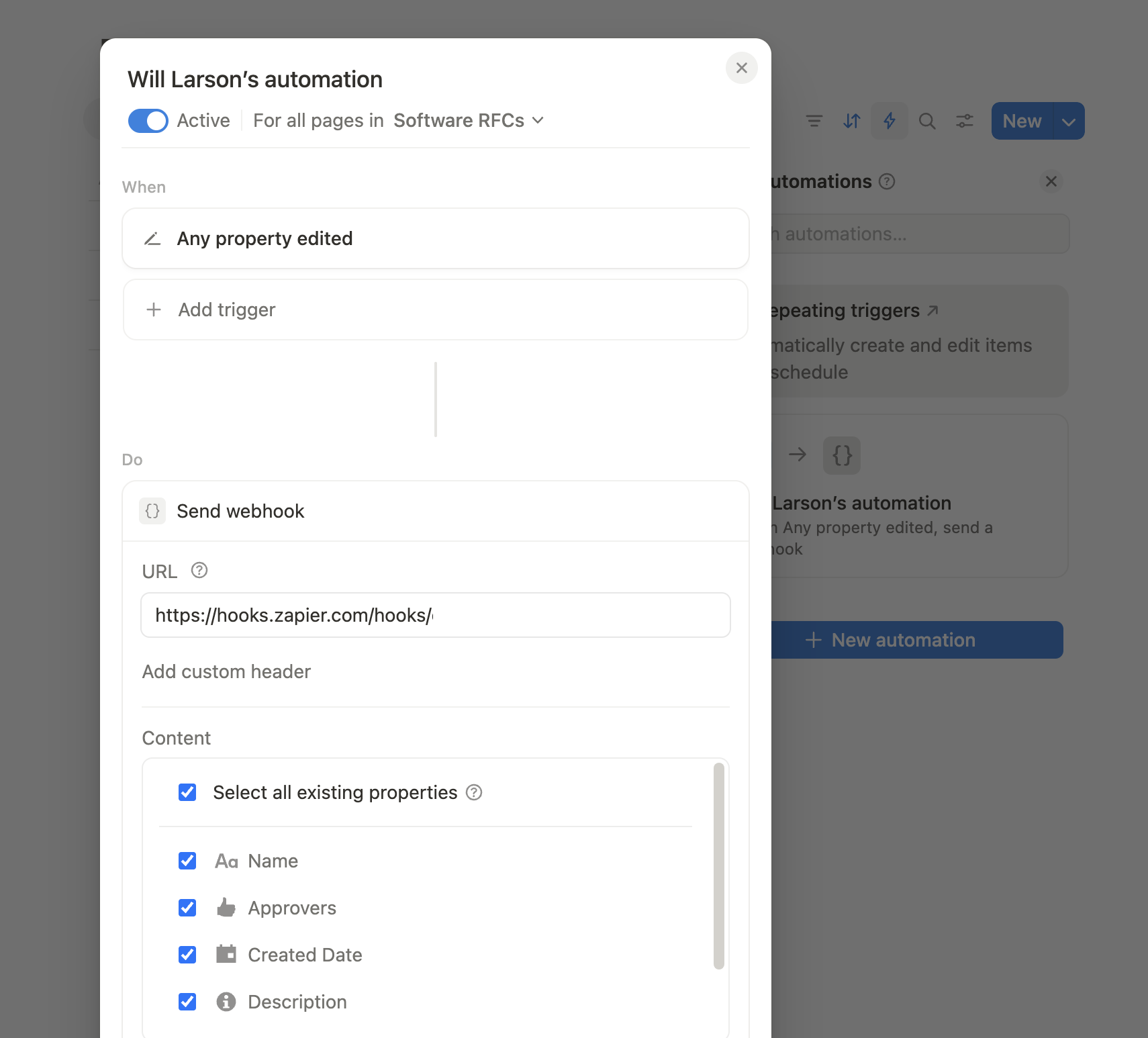
The Zapier webhook does a variety of things that culminate in using the RFC prompt to provide feedback on the specific RFC as a top-level comment in the RFC.
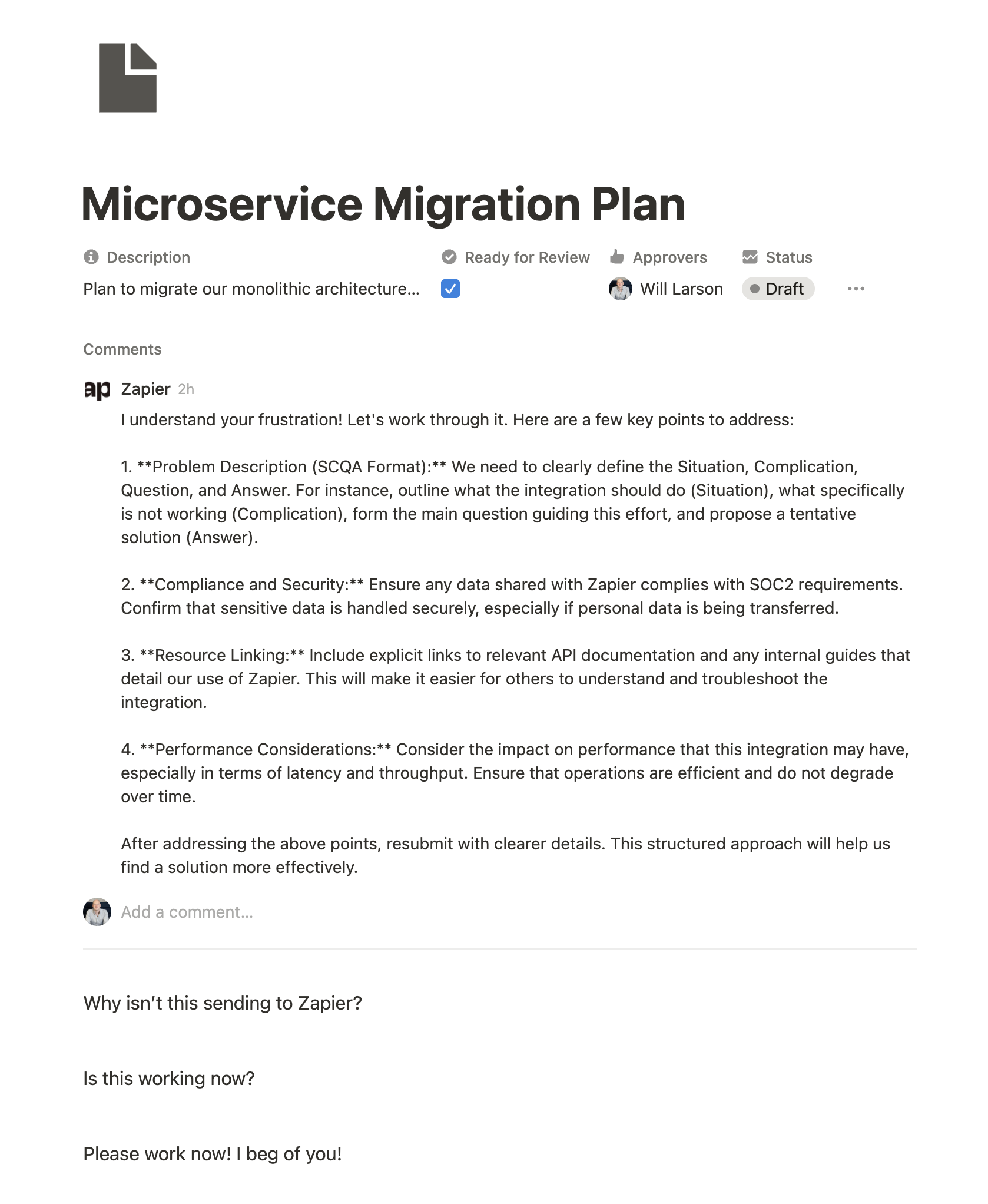
Altogether this works fairly well.
The best thing about this approach is that it actually works, and it works fairly well. However, as we dig into the implementation details, you’ll also see that a series of things are unnaturally difficult with Zapier:
md2notion
Ultimately, I could only recommend this approach as an initial validation. It’s definitely not the right long-term resting place for this kind of approach.
I already covered the Notion side of the integration, so let’s dig into the Zapier pieces a bit. Overall it had eight steps.
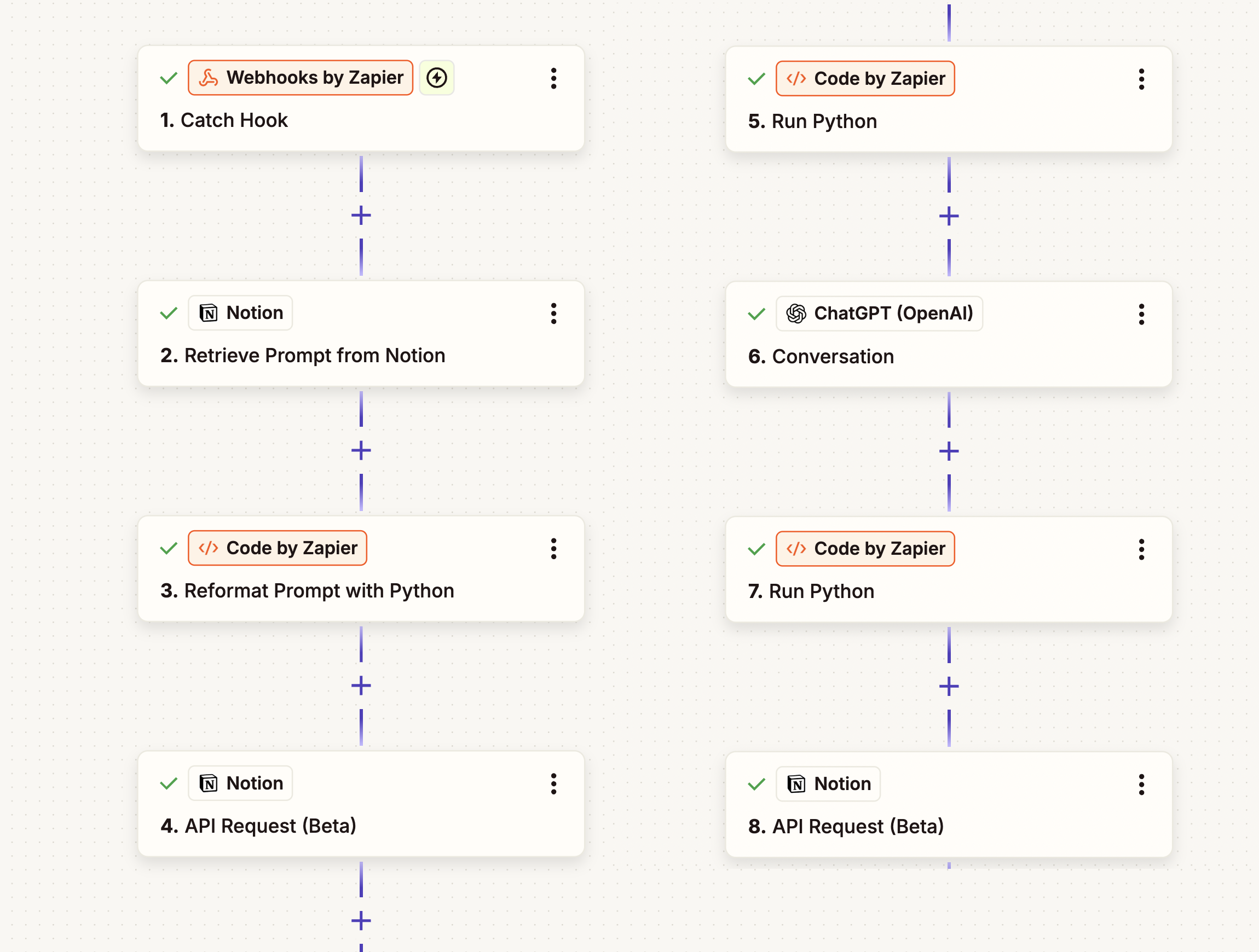
I’ve skipped the first step, which was just a default webhook receiver.
The second step was retrieving a statically defined Notion page
containing the prompt. (In later steps I just use the Notion API directly,
which I would do here if I was redoing this, but this worked too.
The advantage of the API is that it returns a real JSON object,
this doesn’t, probably because I didn’t specify the content-type header or some
such.)
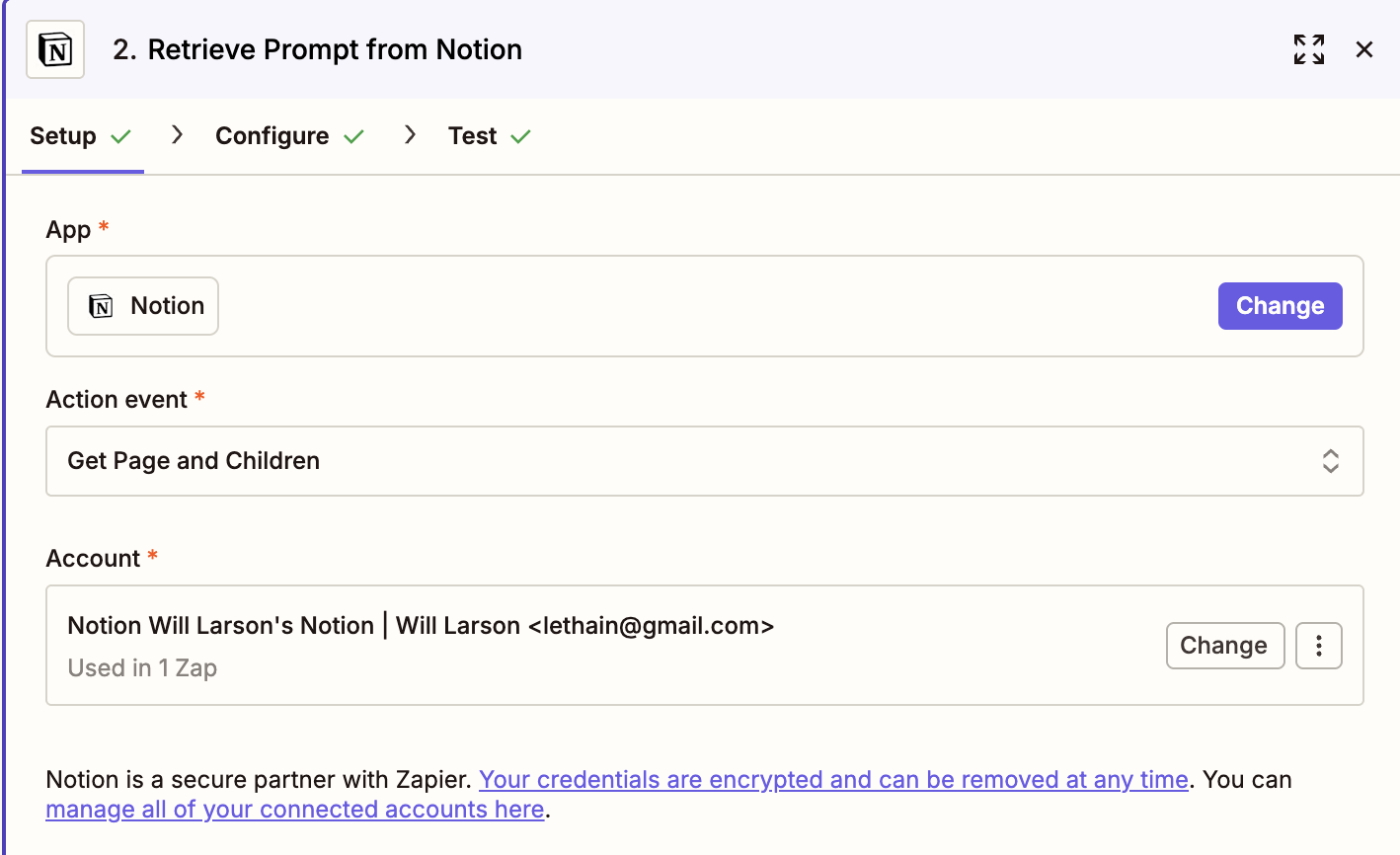
This is the configuration page of step 2, where I specify the prompt’s page explicitly.
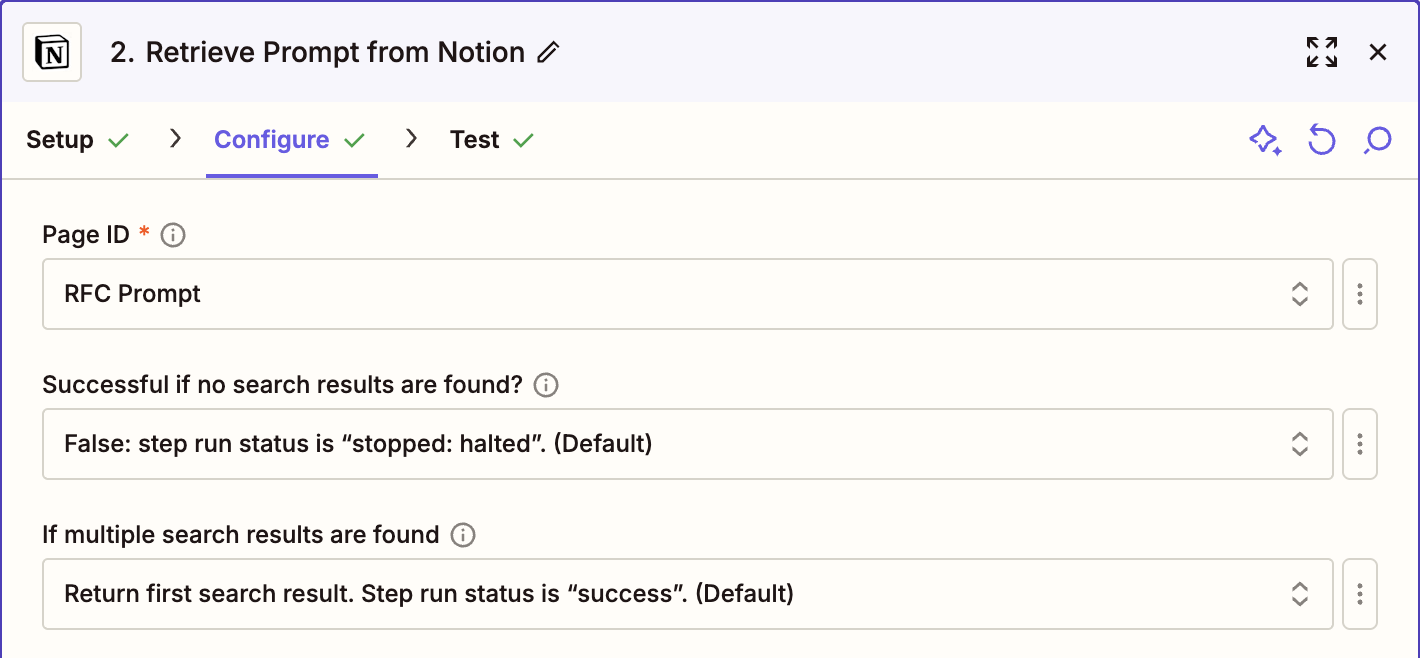 )
)
Probably because I didn’t set content-type, I think I was getting post formatted
data here, so I just regular expressed the data out.
It’s a bit sloppy, but hey it worked, so there’s that.
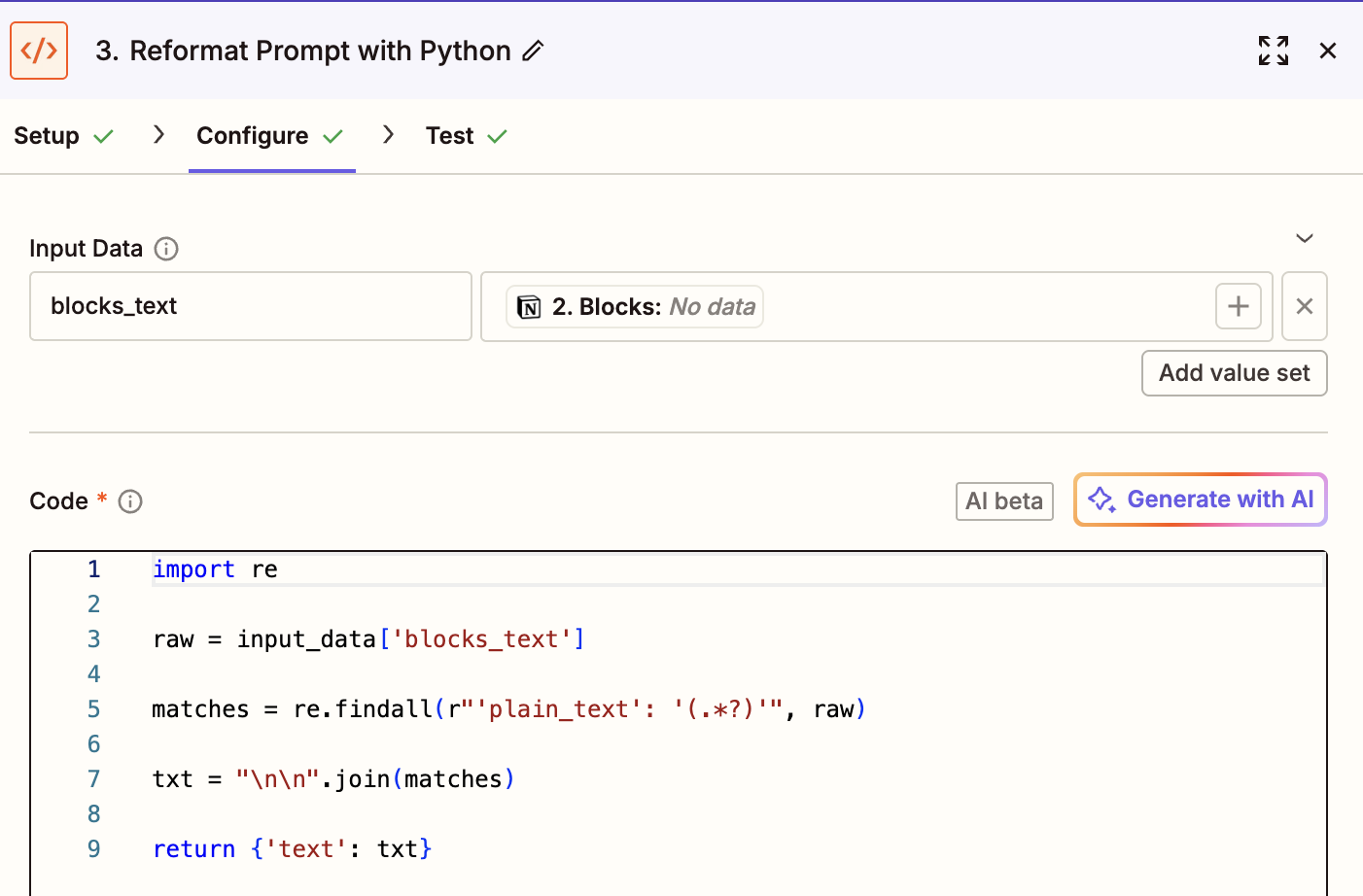 )
)
Here is using the Notion API request tool to retrieve the updated RFC (as opposed to the prompt which we already retrieved).
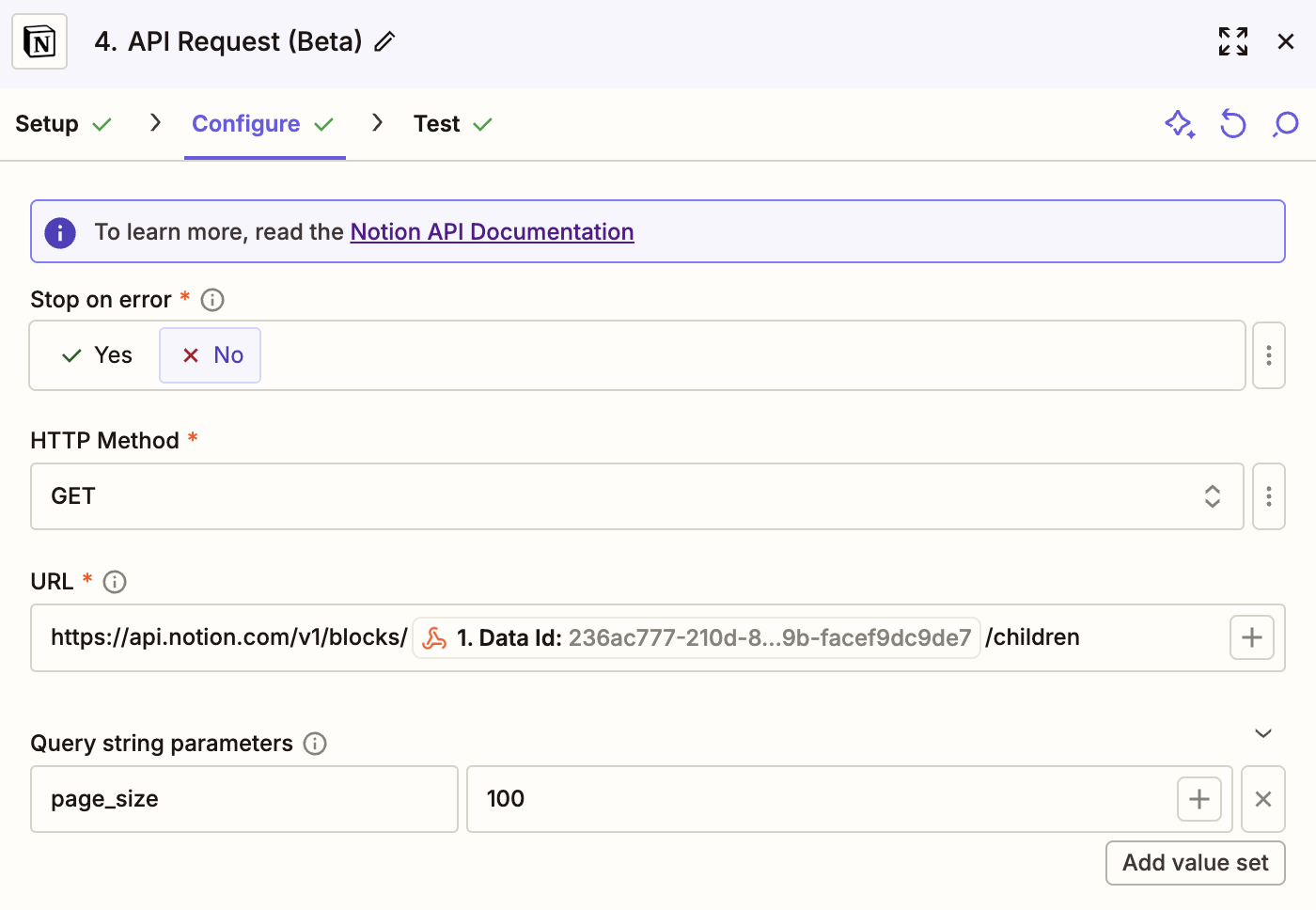 )
)
The API request returns a JSON object that you can navigate without writing regular expressions, so that’s nice.
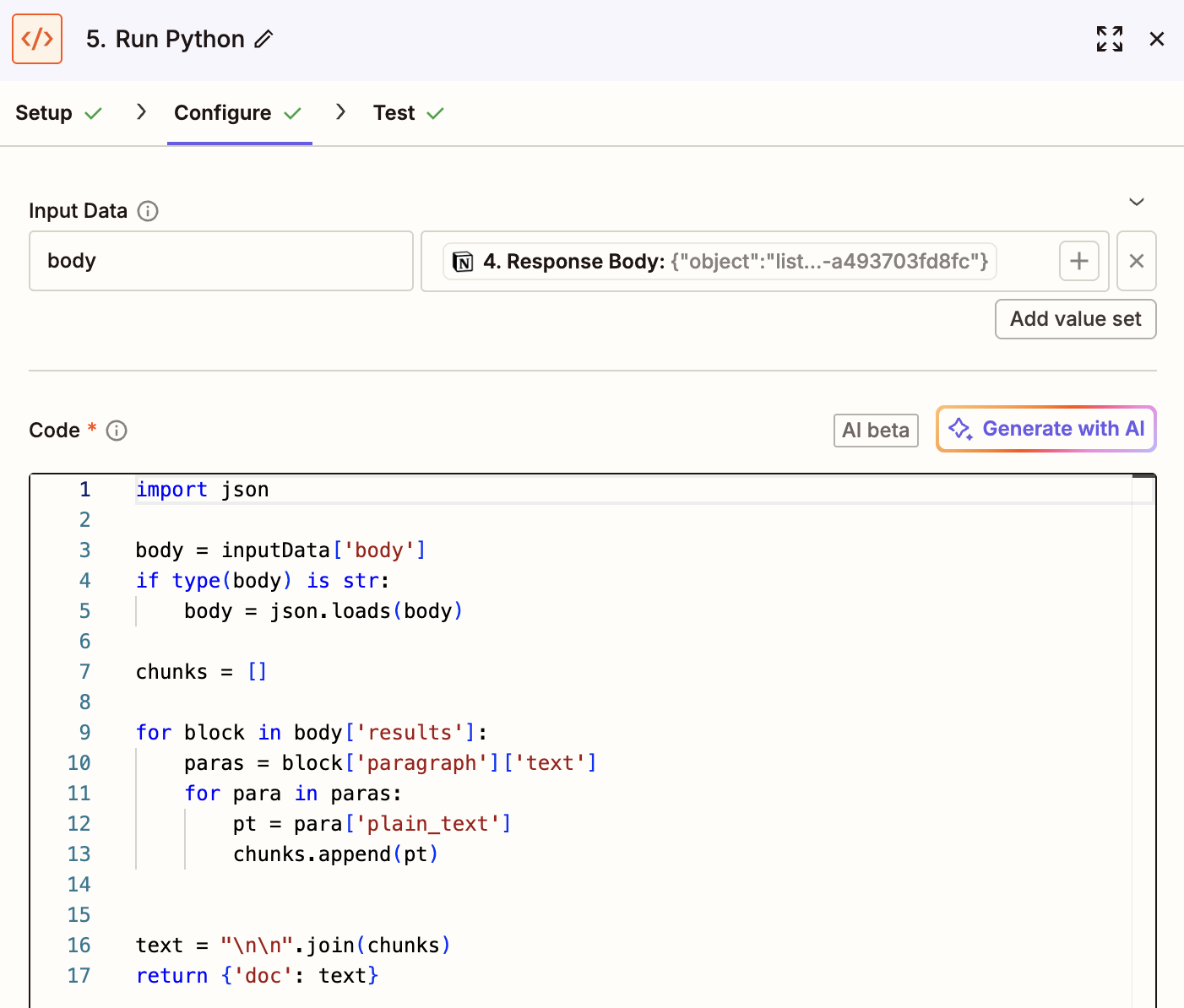 )
)
Then we send both the prompt as system instructions and the RFC as the user message to Open AI.
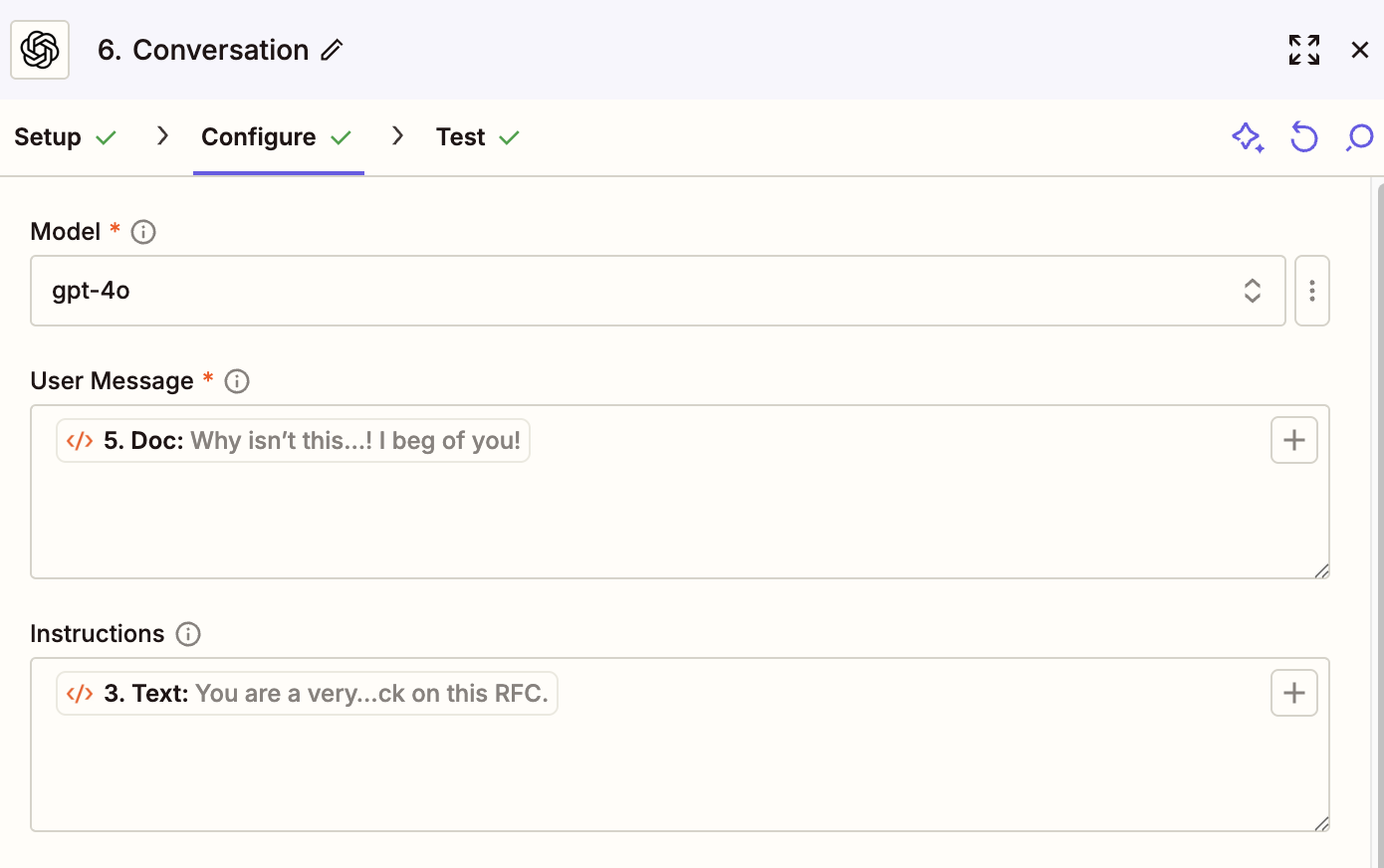 )
)
Then pass the response from OpenAI to json.dumps
to encode it for being included in an API call.
This is mostly solving for newlines being \n rather than literal newlines.
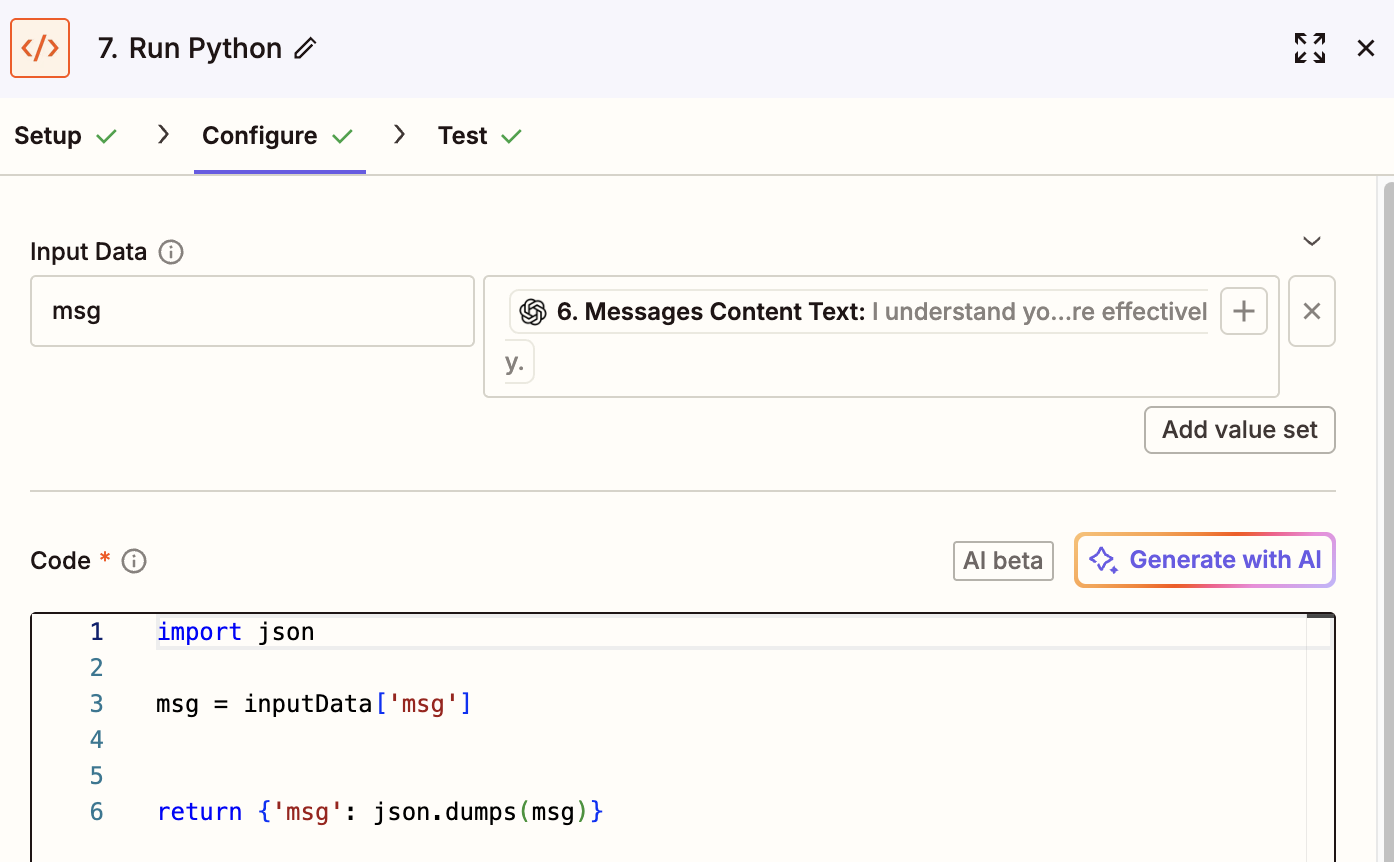 )
)
Then format the response into an API request to add a comment to the document.

Anyway, this wasn’t beautiful, and I think you could do a much better job by just doing all of this in Python, but it’s a workable proof of concept.